













LET’S GIVE THANKS; WINTER IS FINALLY OVER. Dead, buried and put away for another year. Hello, spring; you’ve been a long time coming. Here comes a rush of local asparagus, fiddleheads, market fresh salads, grilled everything, and a glass of cool Pinot Gris on the deck. Oh yeah!
To celebrate, photographer Rebecca Wellman has developed a recipe for a first-of-theseason asparagus salad with Salt Spring Island goat cheese, pickled golden beets, and toasted hazelnuts. It’s easy to make and sings of spring.
We also head outdoors to the barbeque. I love a classic hamburger, of course, but this time we’re firing up the grill with a “fusion” Asian burger that mixes ground pork with fresh prawns, topped with a Bánh Mì slaw and a spicy avocado wasabi aioli - all inside a toasty pretzel bun. It’s juicy, and it’s loaded with umami. Elsewhere, EAT scribes write about ethical meats, the poke trend, adventurous culinary travel, a brewer turned boxer for a good cause, and how the Cowichan Valley is becoming a destination of choice for food entrepreneurs.
Finally, I’m pleased to announce our first EAT Talks - an evening of food, drinks, and inspired talks from a variety of speakers. The theme for the inaugural talk is “Let’s Not Open A Restaurant”; we'll hear from entrepreneurs who are opening/have opened different styles of food businesses. See pg. 10 for details.
The Salt and Pepper Fox is now open at 539 Johnson St. Owner Liam Quinn now offers an inspired selection of homemade sandwiches and salads for pick up as well as delivery service.
SALTANDPEPPERFOX.COM
La Tortilla Mexicana, Esquimalt’s favourite authentic Mexican restaurant, has plans to open a second location on Quadra in the former Rathskeller space. Stay tuned for more details.
LATORTILLA.CA
Foo Ramen chef Patrick Lynch has taken over the former Smoken Bones space in the Hudson with the intention of creating a communal commissary kitchen. Those interested in utilizing a centrally located, clean, fully kitted kitchen are invited to email patrick@foofood.ca


El Furniture Warehouse opened their self-described “westcoast inspired premium dive bar” at 533 Yates St. The Warehouse Group has restaurants across Canada. WAREHOUSEGROUP.CA
The Little Skewer Bar has opened at 1871 Oak Bay Ave in the space that was previously Confit.
Kunal Ghose, the mastermind behind Red Fish Blue Fish and Fishhook here in Victoria, has recently introduced Vancouver to an exciting new fusion cuisine. Masaladobo Cantina & Take Away is located at 433 Granville St. and uses thoughtfully sourced ingredients inspired by Indian favourites and prepared Mexican style. The menu is almost entirely gluten and dairy free and includes specialties such as Ginger Duck Kebab Tacones and the Masaladobo bowl with Tikka seared sockeye with curry gravy.
MASALADOBO.COM
Sterling Silver Premium Beef is melt-in-your-mouth tender and a Thrifty Foods exclusive.
We’re proud of our butcher-quality Sterling Silver Premium Beef. It’s hand selected and carefully aged, then custom cut in stores by our meat department experts. We bet you’ll be blown away by how juicy,

On May 6 , join local farmer and food systems activist Michael Ableman at Olo for a reading from his new book, Street Farm: Growing Food, Jobs and Hope on the Urban Frontier. Tickets are $55 and include a signed copy of the book, a beverage and bites. The event benefits Sole Food Street Farms in Vancouver. EVENTBRITE.CA
The Cheese & Meat Festival will take place on May 20 at Crystal Gardens. Enjoy bite size tastes of cheese and meat while pairing the bites with wine, beer, and cider. See thir ad on pg. 13 or visit

CHEESEANDMEATFESTIVAL.COM
This year marks the 10th annual Terroir Symposium in Toronto, described as “a gathering of dreamers, disruptors and international luminaries in the world of food”. The annual event, taking place on May 29th, 2017, attracts over 1,000 movers and shakers from the hospitality industry including chefs, food and drink experts, writers, advocates, and business leaders. This years’ theme entitled, Our Home and Native Land: Celebrating Canadian Gastronomy, will include presentations by Canadians – both nationally and abroad –
and will focus on the history, leadership and diversity of the Canadian Landscape. Tickets & program info are available online at TERROIRSYMPOSIUM.COM
Well-known wine expertPamela Sanderson has started a new business called Hire a Somm providing Sommelier Services to both the trade and the public. The company offers wine training, tastings and presentations. Email pamela@hireasomm.ca
YYJ Eats is fun night celebrating local food and spirits brought to you by the Greater Victoria Chamber of Commerce. Taste beer, food, wine and spirits from Chamber members in a relaxed outdoor environment. June 13 , 5-7pm at St. Ann’s Academy. Tickets are $50, includes 10 tasting tickets. Additional tasting tickets will be on sale at the event. Please note this is 19+ event.
VICTORIACHAMBER.CA

Blue Grouse Winery in the Cowichan Valley will be hosting a four part “Hire a Somm ” wine education series covering wines from Vancouver Island, British Columbia and other parts of the world. Guests can sign up for one or all four. Classes start at 11am and last for about an hour and a half. Blue Grouse is offering an optional lunch afterwards. $65 per class, or $200 for all four. Classes offered May 27, June 24, July 22 and Aug 26.
BLUEGROUSE.CA
EAT TALKS presents “Let’s Not Open A Restaurant”—an evening of food, drinks and speakers at Norther Quarter on June 12 See pg. 10 for more details.
EVENTBRITE.CA
Fernwood’s favourite food and drink tasting event is back for its 8th year on June 18. Join friends and neighbours at Fernwood Bites in beautiful Fernwood Square and taste the best food and drink from over local 30 restaurants, breweries, distilleries, cideries and wineries. All food and drink samples are included with the purchase of your ticket. This is a 19+ event.
FERNWOODNRG.CA
The Victoria Branch of the Canadian Culinary Federation (CCF) has announced their 2017 /18 Board of Directors. This
year’s President is Mark Davie, Executive Chef, University Club of Victoria and the Vice-president is Steve Walker-Duncan Chair , Culinary Arts, Camosun College. The Branch is comprised of cooking professionals and industry partners that mentor youth, give back to the community, support students awards, and provides educational and other networking opportunities.
CCFCC.CA
Northern Quarter has teamed up with designHouse Salon to co-create a recipe using local ingredients inspired from the food used as an active ingredient in the Davines essentials line of shampoos and conditioners. They decided on a local champion of sustainability, the Ling Cod. The recipe won 1st place in North America and is included in the book 31 Days of Local Food. Diners will be able to order chef Toren Egan ’s winning recipe from the menu at NQ for the month of June with $1 from each order donated to Vancouver Island Slow Food. NORTHERNQUARTER.CA
Exciting change is afoot at the Oceanic Market on Catherine Street in Vic West. Ryan Timothy Townsend, owner of the Market Garden, is now leasing the store in addition to the back garden space. The store now stocks all organic produce and is planning to include a coffee counter and an old-fashioned penny candy selection. Plant starters and organic seeds are also available. THEMARKETGARDEN.CA





FOUNDER & EDITOR
Gary Hynes
PUBLISHER
Pacific Island Gourmet
CONTRIBUTING EDITOR
Carolyn Bateman
VANCOUVER CONTRIBUTING EDITOR
Julie Pegg
SENIOR WINE WRITER
Larry Arnold
PRODUCTION
Gary Hynes
DESIGN CONSULTANT
Aleya Samji
COPYEDITOR
Cynthia Annett
REGIONAL REPORTERS
Tofino Ucluelet, Jen Dart
Victoria, Rebecca Baugniet
Cowichan Valley-Up Island, Kirsten Tyler
CONTRIBUTORS
Larry Arnold
Joseph Blake
Michelle Bouffard
Isabelle Bulota
Cinda Chavich
Jennifer Danter
Pam Durkin
Jose Miguel Mendez
Elizabeth Monk
Michaela Morris
Daisy Orser
Elizabeth Nyland
Adrian Paradis
André Rozon
Adrien Sala
Shelora Sheldan
Jill Van Gyn
Johann Vincent
Rebecca Wellman
COVER


Isabelle Bulota (styling) & André Rozon (photo)
ADVERTISING DIRECTOR
Gary Hynes
SENIOR ACCOUNT MANAGER
Susan Worrall
DIRECTOR OF BUSINESS DEVELOPMENT
Jen Kinna
FACEBOOK/EATMAGAZINE
The BC Shellfish and Seafood Festival is one of the largest festivals of its kind in western Canada. It takes place from June 9 - 18, 2017 in Comox Valley and has over 35 events ranging from gala dinners to chef demonstrations to tasting booths. Participating restaurants will feature special dishes. There’s an oyster shucking competition, a chowder challenge, live entertainment and BC craft beers and wines. For more info and to purchase tickets visit BCSHELLFISHFESTIVAL.COM Don’t delay tickets sell-out fast.

TWITTER/EATMAGAZINE
INSTAGRAM/EATMAG
For advertising and other inquiries:
PHONE 250.384.9042, EMAIL editor@eatmagazine.ca
ONLINE EatMagazine.ca, TheEatJournal.com
MAILING ADDRESS Box 5225, Victoria, BC, V8R 6N4
STOCKISTS EAT is delivered to over 300 pick-up locations in BC. Visit our website for locations.
PRINTED IN BRITISH COLUMBIA
EAT ® is a registered trademark.
Est. 1999












I WAS NOT WOWED THE FIRST TIME I TRIED poke. The tuna/soy-and-sesame/avocado concoction atop rice was fresh and tasty enough, but I failed to “get it.” However, when fast-food-type poke joints about the size of kiosks started popping up about the city, I figured I’d better look into the phenomenon. Starting with a background check.
I learned that poke, pronounced po-kay, is a Hawaiian word meaning “cut piece” or “small piece,” but don’t dare embellish the word with a French accent aigu (é). An island chef may scoff and say there is no such word. I had a devil of a time turning up anything further on poke history until I stumbled on a beautifully wrought excerpt from The Food of Paradise: Exploring Hawaii’s Culinary Heritage by historian Rachel Laudan. She offers a brief account of the islands’ fishing history and the Hilo fish auction on the Big Island before segueing into poke. She writes, “A fishing boat pulls up, its turquoise paint faded and peeling. An elderly man, tall for a Hawaiian, but stooped from years of labor, and











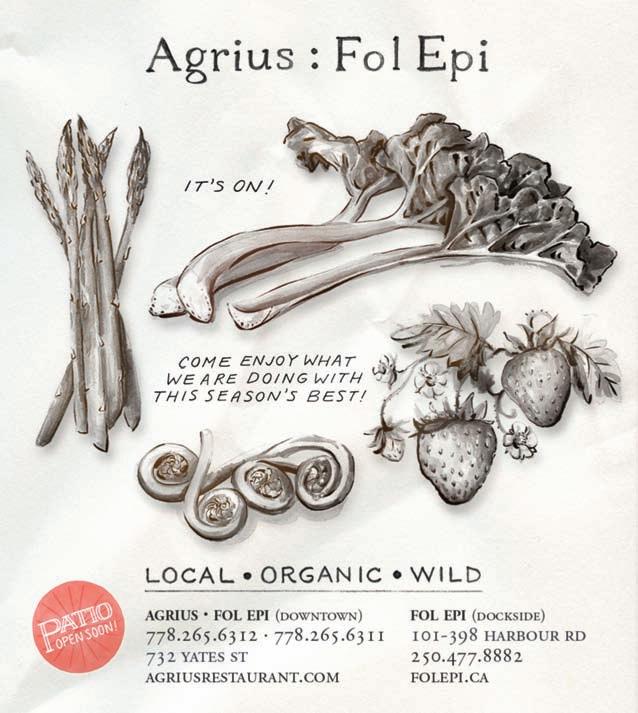
wearing a T-shirt and pants grimy from his work, pulls a huge fish from his cooler and heaves it up to add to the auction.” This poignant recount reminds me, just a little, of Hemingway’s Old Man and the Sea. Although the Hawaiian fisherman and his fish fare considerably better than Santiago and the skeletal marlin, I am struck by the same strength, determination and raggedy boat, and by his deep connection to the sea and fishing.

Originally poke was very likely humble fare for a fisherman and his family—a kind of rough-and-tumble sashimi, made with raw reef fish (and still is in some places) until albacore, ahi or yellow fin tuna (and octopus) became the norm. Fresh seaweed, Hawaiian rock salt and the nutmeat from roasted kukui nuts (candlenuts) were the only add-ins.
Today’s build-your-own poke places have widely and wildly strayed from that simple mixture, so widely in fact that not one of these ingredients exists in many mix-and-match pokes. Proteins include salmon, scallop, tofu or grilled chicken breast, or none at all. They may get punched up with any or all of carrots, corn, pineapple, potato salad, avocado, mango, tomato, watermelon, jalapeño, scallions and what have you.
Various sauces include (often too much) ponzu, wasabi, soy/sesame or sweet chili. Some places serve up poke paninis, tacos, burritos and even poke nachos. The base for a poke bowl could be kale or other greens, quinoa, brown, purple or sushi rice (a no-no for many poke chefs who believe the rice should never be sweet). It’s easy to play fast and loose in building your own poke unless you know how to balance texture and flavour. Two restaurant chefs show good taste and, in my view, wise restraint. Chef Soojin Park at the new Lift Bar and Grill at YVR naps fresh tuna, cucumber, green onions and avocado nicely with sesame and serves it with tortilla chips instead of nori. Black +
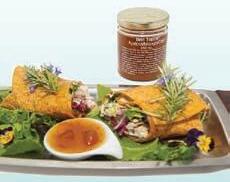
separate mounds of cubed buttery tuna, creamy avocado, golden tobiko pearls, toasted rice, melt-in-your-mouth slivers of wakame (dried seaweed) and coconut in a shallow bowl. Ponzu sauce, housemade salt and smoked chili chips are set individually alongside. Usually the server tosses and dresses the poke tableside as one does with a Caesar salad. I request chopsticks and sea salt, skip the coconut and prefer to do my own mixing as I do with steak tartare. I crumble a few of the chips onto the poke. The meld is at once saline, savoury, earthy, crunchy and creamy—delicious and incredibly fresh.
Seattle’s Sam Choy takes Poke to Da Max. Literally—it’s the name of his food trucks, which dish up and gussy up all manner of pokes. But I like adapting Raudan’s two simple pokes—cubed ahi tuna or octopus (tako) mixed lightly with a smattering of scallions, rock salt, macadamia nuts and dash of soy sauce. I pop my rendition atop cooked plain white rice—rather like poke meets chirashi. That wows me.

Spring's arrival delivers successive tender and young ingredients, aromas, and delicate flavours to maximize your experience.
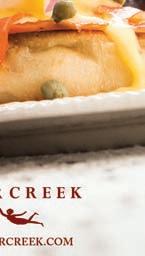












WITH A PARTICULARLY LONG AND CHILLY WINTERBEHIND US,AND snow shovels safely stowed away, you might say we are starving for glimpses of spring and the vibrant flavours that accompany it. Gastronomically spoiled as we are on Vancouver Island, there is still no food season as welcome as spring.
While many local crops are far from harvest, fiddleheads are a wild delicacy available for a brief window signifying the start of B.C.’s bountiful harvest season. Due to the short season and the fact that fiddleheads are only wild harvested, they remain elusive and highly coveted.
Found throughout Canada, fiddleheads can be foraged in southern B.C. but are less common than they are in northern areas like Smithers, where they abound. The fiddlehead as we know it is the unfurled spiral tip of the ostrich fern wild harvested when still tight a couple of inches above the ground (though the fiddlehead of the lady fern is also edible, it is considered less desirable). Note: The mostly widely available fern on Vancouver Island, the sword fern, is not suitable for eating. Local foragers tell us that due to our mild climate, the spiral unfurls very quickly, making the harvesting opportunity extremely brief. Keep your eye to the ground, know your fern varieties, and you may get lucky when hiking in our forests near riverbeds and marshes.
Fiddleheads are ready when they’re ready, and the window is brief, but because
foragers frequent different locations each with varying micro-climates, they will have patches of fiddleheads ready for harvest at staggered times allowing for a perceived harvest season of up to three to four weeks from late April to late May. Be in touch with local foragers or find them at specialty markets, but only purchase from reliable sources. Choose fiddleheads with firm, tight coils and bright colour. Gently brush off any remaining brown chaff and wash thoroughly. Fiddleheads cannot be eaten raw; they contain toxins that will cause stomach upset. Boil (eight minutes) in salted water or steam (20 minutes) prior to following recipe instructions. Because they deliver such vibrant green flavour with a subtle nutty finish, simple preparations best complement the fiddlehead. Sauté in butter with a high quality garlic, shallot or perhaps leek, fresh cracked pepper and some Vancouver Island sea salt for a beautiful accompaniment to white fish or substitute in any asparagus recipe; think fiddlehead frittata. If you happen to have an abundance of fiddleheads, they can be easily frozen after blanching for later use or pickled with stunning results.
If you’re looking for a memorable culinary experience this spring, it’s all about the fiddlehead. Champions of nutrition, sustainability and taste, this wild delicacy is a delight we are fortunate to have at our fingertips. Take a walk on the wild side; it’s delicious there.
Daisy Orser is co-owner of The Root Cellar Village Green Grocer

TASTE: Fiddleheads offer a taste reminiscent of asparagus, but with a distinct nutty, green taste of the wild that you just can’t grow in your garden.
TREND: If you see fiddleheads on a local restaurant menu—order them. They won’t be there long.




SUSTAINABILITY: If foraging for your own fiddleheads, sustainable harvesting is essential. Harvest no more than 10 percent of what each plant has to offer.
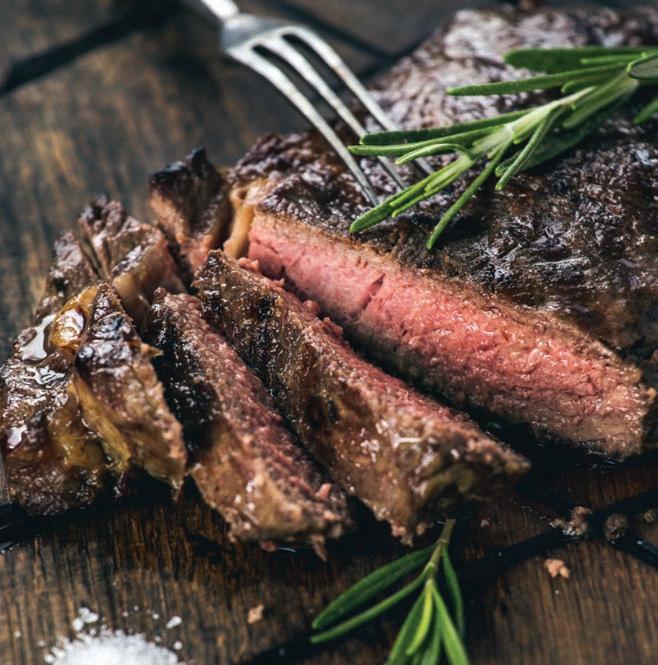
SELECTION: Choose tight, bright spirals free of any yellowing from reliable sources.


PREPARATION: Never consume raw. Once boiled or steam, fiddleheads favour simple preparations that allow their distinct spring flavour to shine.
STORAGE: Store clean and dry in the fridge if you must, but fiddleheads are best consumed as quickly as possible while flavour and nutrient density are at their peak.
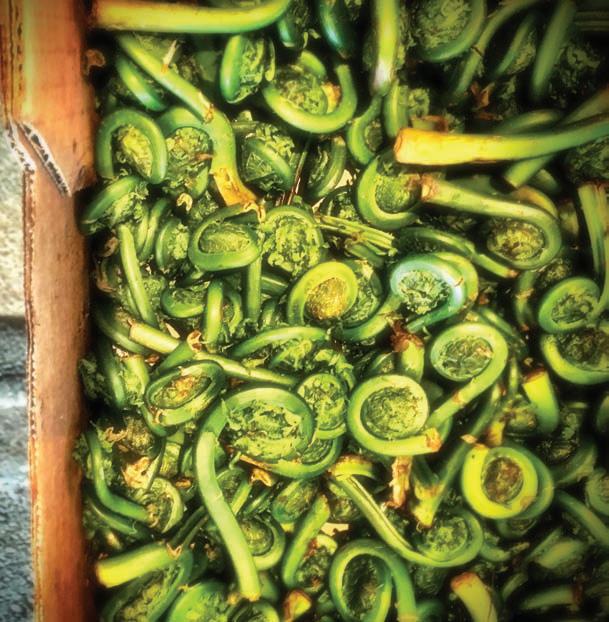
Fiddleheads are an edible masterpiece boasting brains, beauty and brawn. Wild harvested, nutrient dense and delicious, what’s not to love?

We’ve all said it at one point in our lives: “I would love to open a restaurant.” Whether a chef, dishwasher, lawyer or mechanic, many of us have thought that if we just had the money and the time, we could open the perfect restaurant. Today, dreams of opening a restaurant are dwindling. High overhead costs, soaring food prices, ridiculous rent increases and creative competition mean it’s a tougher game than it once was. So, what is one to do? Throw in the towel? Move on to “greener pastures”? Kick, scream, cry and lament? Heck, no. We create new and exciting ways to remain involved and integral to the food industry. In fact, not opening a restaurant has created a multitude of cottage industries that have breathed fresh life into how we approach food.
Today we are seeing innovation flourish in the face of all of the issues that tend to plague the restaurant industry. People are pushing aside the idea that a restaurant is the only way to contribute to the food industry in favour of food revolutions through technology, creative small businesses and alternative routes to getting their big food idea out there. Victoria is awash with new food apps, community kitchens, mini brick-andmortars and small producers. What, where and how we are eating have become exciting again. The cottage industries springing up around the food industry are surpassing the cottage stage and are becoming the disruptors and drivers of Victoria’s food scene.
Eat Magazine and The Northern Quarter are bringing together industry insiders who have carved out their own unique niche. On Monday, June 12th, flanked by food and drink, of course, our collection of speakers will tell the story of how they got where they are, what they do and how their idea fits into the future of food. So, if you’ve ever considered not opening a restaurant (or perhaps that idea still floats through your mind from time to time) join us for a night of stories, inspiration and ideas.
JILL VAN GYN, EAT TALKS MODERATOR

DESCRIPTION: LET’S NOT OPEN A RESTAURANT

“An evening of food, drinks and inspired talks.”
SPEAKERS: Sterling Grice, Restaurateur (Foo, Foo Ramen, Part and Parcel), Daniel Elder - Ice Cream Subscription Program (49 Below), Corey McPherson and Alyssa Talley - Meal Kit Delivery (Local Urban Bites), David Mincey - retail (The Chocolate Project & Circle Canning), Jill Van Gyn, food producer (Fatso), writer (EAT)... TBA - more speakers to be announced. Visit Facebook.com/EATmagazine for updates
DATE: Monday, June 12, 2017


TIME: 6:30pm to 9:30pm
WHERE: Northern Quarter (1724 Douglas St, Victoria)







TICKETS: $20 (includes appys and a first drink thanks to our sponsors Hoyne Brewery, Tod Creek Craft Cider and Unsworth Vineyards) To purchase tickets: visit www.eventbrite.ca and search ‘EAT TALKS - LET’S NOT OPEN A RESTAURANT’







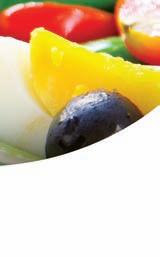


POISED ON THE CUSP OF SUMMER, MANY PEOPLE START TWEAKING their diets with an eye to getting “beach-body ready.” Unfortunately, a far too common mistake made in this pursuit is to eliminate carbohydrates in the belief that they are unnecessary fattening foes. What’s the real truth?
Carbohydrates are one of the main nutrients your body needs to function and its preferred source of energy. Sure, science has revealed refined carbohydrates, like cookies, white rice and white bread, can derail diets and sabotage overall health. However, an overwhelming body of evidence shows that consuming complex carbohydrates, such as whole grains, vegetables and legumes, is not only über-healthy, it can also help us stay trim. This impressive “good-for-you” factor can be further enhanced with the following carb strategies, which can turn carbohydrates into fat foes, rather than fattening foes.
If you’ve sworn off pasta to stay fit and healthy, consider Sardinia. The western Mediterranean island is one of the world’s “Blue Zones,” places where the world’s healthiest and longest living people reside, and its residents chow down on pasta two to three times per day. However, unlike us North Americans, Sardinians serve their pasta al dente, meaning “firm to the bite.” Why is that important? When cooked, noodles that are “firmer” cause a slower rise in blood sugar and take longer to digest than overcooked, soft noodles. Studies show these effects are critical for maintaining a healthy weight and a good energy balance throughout the day.
Here’s more intriguing news. Investigators at the BBC recently found that longer, slender noodles, like spaghetti, have a lower glycemic index (rate at which they raise blood sugar levels) than thick short shapes like macaroni. So go ahead, make like a Sardinian and dig into a hearty bowl of pasta—just watch how you cook it and pick the right shape.






There’s no reason to forgo the bread basket as long as you fill that basket with sourdough bread. Sourdough undergoes a fermentation process that alters its starches, changing the way it is digested in the body. This fermentation process not only reduces the bread’s glycemic index, it enhances its protein, mineral, fibre and phytochemical content. What’s more, this same fermentation process creates beneficial bacteria that help keep our immune systems strong and our digestive tracts functioning optimally. These beneficial bacteria—a.k.a. probiotics—have also been shown to help with healthy weight management.


Many trendy diets, such as Whole30 and the Paleo diet, claim that eating grains is bad for your health and can lead to weight gain. While refined grains have been linked to health problems like inflammation and obesity, the opposite is true of whole grains. A plethora of studies show eating whole grains can actually reduce the risk for heart disease, obesity, cancer, inflammatory disorders and more. So what’s the carb trick that makes these already nutritious victuals even healthier and more diet-friendly? Sprouting! Scientific analysis reveals sprouted whole grains contain more protein, antioxidants and key vitamins and minerals than regular whole grains. In addition, they contain less carbs, gluten and calories than their un-sprouted counterparts.

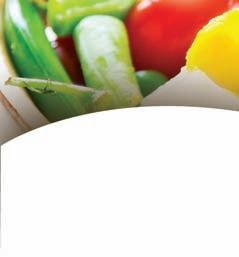
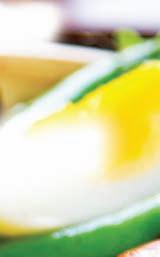
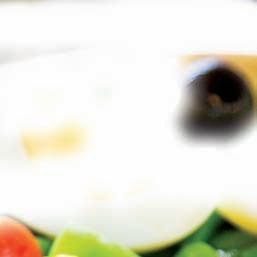
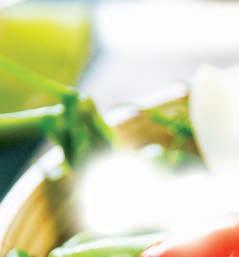
RECIPE
INGREDIENTS
QUICK PICKLED GOLDEN BEETS
1 lb golden beets (about 3 medium)
2 tsp sugar
½ cup apple cider vinegar
2 Tbsp fresh thyme leaves
1 garlic clove, peeled and smashed
1 3-inch sprig fresh rosemary
1 Tbsp kosher salt
1 tsp yellow mustard seeds
ROASTED HAZELNUTS
⅓ cup raw hazelnuts
Salt to taste
GOAT CHEESE
(Use a good quality goat cheese from your local cheese monger if time is an issue.)
1 quart goat’s milk
¼ cup fresh lemon juice
Up to ¼ cup white vinegar*
1 tsp salt
Zest from one lemon, finely chopped
Cheesecloth
GRILLED ASPARAGUS
1½ lb asparagus
PAIR THIS ICONIC HARBINGER OF SPRING WITH GOLDEN BEETS, GOAT CHEESE AND HAZELNUTS.

RECIPE AND PHOTOGRAPHY
Rebecca WellmanSpringtime is upon us. We can put away the slow cooker and the braising pot, turn down the furnace and tuck the extra blankets away for another year. With spring comes longer days, blooming gardens and the bright flavours of fresh produce like local asparagus. So many flavours complement the earthy, snappy taste of this flowering perennial, and the best ones (as usual) coming from our own kitchens. Enjoy this dish as an accompaniment to grilled meat, chicken or fish, or simply on its own as a light lunch with a loaf of crusty bread and a crisp Sauvignon Blanc.
1 Tbsp olive oil
1 clove garlic, minced
Salt and pepper to taste
TO PREPARE THE BEETS
Trim stems from beets, scrub clean and boil in water for about 30 minutes, or until tender.
Remove from water, retaining 1 cup of the water, discard the rest, and let the beets cool completely. Peel and cube the beets and place in a medium-sized bowl.
In a small saucepan, combine sugar, apple cider vinegar, fresh thyme, garlic, rosemary, salt and mustard seeds. Add ½ cup of the reserved beet water. Bring to a light boil, then turn down to simmer for about 5 minutes. Remove from heat and let cool completely. Strain the solids out of the liquid. Pack the cubed beets into a sterilized 500 mL jar. Pour cool liquid over top, cover with a plastic lid and refrigerate overnight.
Preheat oven to 375°F. Spread hazelnuts in a small cast iron pan (keeps them contained) and roast for about 12-15 minutes, shaking occasionally. Remove from oven and cool completely. Chop into large pieces and sprinkle with a pinch of salt.
In a heavy bottom saucepan, heat goat’s milk over medium heat until it reaches 180°F, stirring frequently, so it doesn’t scorch. Remove from heat and stir in the lemon juice and 2 tablespoons of the vinegar*. Stir until combined and allow it to cool about 15 min. You should see the solids separate from the liquid, leaving a thick layer on top.
Pour mixture into a triple cheesecloth-lined sieve. Wrap cheesecloth around cheese, and hang from your faucet, or tie it around a chopstick and hang over a bowl. Leave it there for about 2 hours, or until it’s firm. Squeeze out more liquid with your hands if desired. Scrape cheese into a bowl and add salt and lemon zest. Mix well.
*The separation of the curds depends on the acidity of the lemon juice and vinegar (the acidity of a lemon will vary, while the acidity of vinegar is consistent). If you notice that the curds and whey are separating nicely you may only need the 2 tablespoons of vinegar. If they aren’t separating, bring milk back up to 180°F and add more vinegar, a tablespoon at a time, until they do.
Preheat oven to 425°F.
Snap the woody ends from the asparagus and coat lightly in olive oil. Place on sheet pan and sprinkle with garlic, salt and pepper. Roast in the oven for 12-15 minutes or until tender. (You can also grill asparagus on a hot grill for 10-12 minutes.)
Place asparagus on serving plate. Sprinkle goat cheese over the asparagus, followed by some pickled golden beets (you’ll have lots left over) and roasted hazelnuts.
featuring featu r ing fe













t abbouleh, pineapple salsa, roasted cauliflower a nd broccoli, tomatoes, cucumber, fresh greens, jasmine rice, miso carrot ginger sauce.
- with grilled chicken, glazed salmon or grilled avocado -

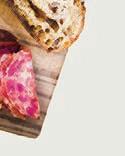




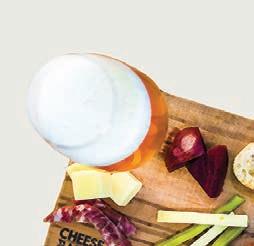


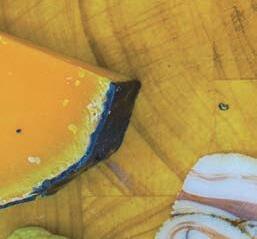






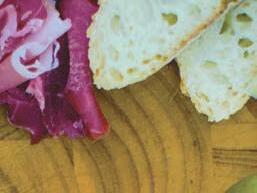
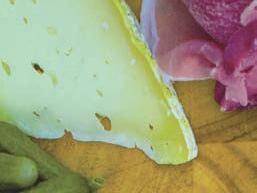


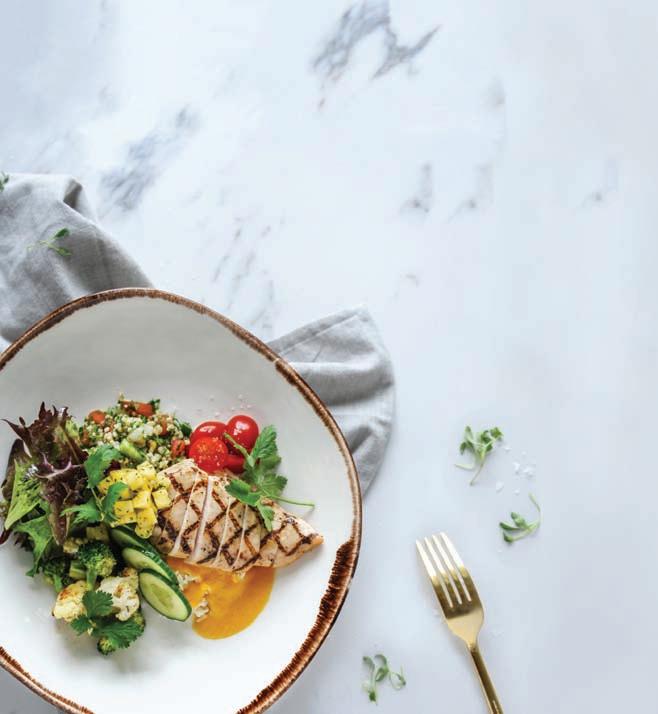


Cinda Chavich
Elizabeth Monk
PHOTOGRAPHY
Rebecca Wellman
Nyland
The weekend that James Davison opened his Very Good Butchers shop in Victoria’s downtown Hudson Market, more than 1,000 people lined up for a chance to taste his Smokin’ Burger and buy a package of his vegan British bangers.
Granted, there was a little gnashing on social media about using the word “butcher” for a meat-free business, but it’s all tongue-in-cheek, says Davison, pointing to the “We Butcher Beans” motto on the chalkboard behind the counter.

And, mostly, Davison is getting a lot of love. So much love that his entire first week’s production sold out in the first 48 hours (and might have been gone the first day if he hadn’t held some back). People lined up for two hours to taste his food.
Apparently they were not disappointed — customers are still coming from all over the island, smitten with his pulled BBQ Jack (jackfruit) sandwiches, vegan tacos, and deli “meats”, from mustard and maple-glazed Roast Beast to breakfast sausages.
But Davison says it’s his vegetarian burger that’s stealing the show.
It’s not the first time I’ve eaten a veggie burger based on
black beans, but this is a different animal. His Very Good Burger and Smokin’ Burger both have the toothy bite of a grilled beef patty and a smoky flavour that comes from charring. But they’re totally plant-based, a clever combination of black beans, beets, carrots, onions, celery and garlic, with barley, oats and seitan (wheat gluten) and spices.
Served on a Portofino bun, with fresh spinach, red peppers, sliced avocado and a raw cashew “cheese” sauce, the spicy Smokin’ Burger is has a chorizo-like flavour and a great meaty texture.

“It looks like a beef burger, fully cooked with the charring that gives the illusion of meatiness,” says Davison. “It differs from the usual vegetarian bean burger in that it will satisfy a meat craving.”
British-born Davison is a classically trained chef. When he moved to Canada in 2012, he worked at Heirloom, a modern vegetarian café that was part of the burgeoning “vegetable forward” movement in Vancouver. It’s where he met his wife, Tania Friesen, and though they both eschew all meat, he still sometimes craves a burger or a banger.
“That’s really why I first tried making vegan meats — for
fun and because I was missing some things,” says Davison. “Sometimes I crave a burger or a sausage for breakfast.”
Very Good Butchers is an artisan producer, using organic, whole foods. The sausages, patties and “beetballs” are handcrafted, formed, steamed and smoked in Davison’s production kitchen on Denman Island. Organic wheat gluten (seitan) is the base, giving his burgers and sausages the bouncy tooth of ground meat. The barbecue Jack sandwich is made with young jack fruit, a giant spiky green fruit from Southeast Asia. The flesh is firm and pulls into fibres like pork so it’s a dead ringer for pulled pork sandwich — at least on the visual side. You don’t get the real pork flavour but, with a smoky barbecue sauce, it’s a tasty, filling sandwich all the same. The couple moved from Vancouver to Denman Island in 2016 to raise their young family, the chef “tinkering” with his faux meat products in his home kitchen before introducing them at the local farmer’s market. When they started sampling their burgers and sausages at the Hudson Market in Victoria, they found strong demand.
BROADMEAD VILLAGE SHOPPING CENTRE, 425-777 ROYAL OAK DRIVE, 778-265-3328
Magic is happening at Broadmead Village. A sexy Japanese restaurant specializing in understated drama has moved in. Fans of sushi chef Shingo Sana have followed him here, so one month into its tenure, the sushi bar is already packed.


Yes, the not-so-flush-this-week can enjoy the good times here. Individual rolls cost between $4.50 and $16.50 for the most elaborate lobster one. Creativity comes through in the Bananacado Roll (that’s not a typo). What sounds like it could be silly is actually sophisticated. Banana is tucked into a roll with very crispy yam tempura flattened and draped on top. The overall effect is reminiscent of a Mexican deep-fried banana because of the interplay of tempura crunch and sweet banana. More sassy than sweet is the Lemondrop specialty roll, a tart little number that could be used as a palate cleanser. The little teardrop-shaped rolls with lime, oba leaf and a little bit of sweetener do indeed have the effect of a lemondrop.
The lunchtime bento box is $17, and it is special. For starters, there’s real crab in the California rolls. Prawns are fat and fresh, the tempura vegetables on my day included asparagus, and the chicken teriyaki is the best I’ve had in town. The stir-fried vegetables included enoki mushrooms, and the garnishes are created with care: Japanese traditional pickles are made in-house, and the eggplant one was marinated in shiso sauce and plum juice for a complex flavour. I would encourage you to one day let loose the purse strings and put yourself in the hands of chef Sana. He’s a natural educator who loves to take you deeper into the world of sushi. If you’re lucky, you might get some Tataki three ways, both salmon and tuna, with ingredients as varied as Cajun dry rub and mustard vinaigrette. Or fresh geoduck. You will get art on a plate no matter what you are presented with. Environmentally conscious EAT readers may want to be aware that on Thursdays, Fudo ships in bluefin tuna fresh from Japan. Although the fish is highly prized by sushi chefs worldwide, sustainable seafood programs such as SeaChoice recommend that diners avoid bluefin tuna, which is severely overfished. seachoice.org





Out of a fire rises not a phoenix, but hot lunches. When the venerable Italian Bakery had a fire in 2014, owner Alberto Pozzolo decided to both retain the spirit of the old bakery and re-jig. In the rebuild, he brought in a full kitchen hood, which meant lunches to eat in and dinners to go. The lunch menu changes but typically has the structure of a soup, a salad, a feature, and two pastas or a pasta and a gnocchi.
On a recent Saturday, the soup and salad were $7, the feature and a pasta were $12, and a gnocchi $14.
My salad came in a medium-sized bowl with warm, toasted bruschetta displayed around it like rays of sunshine. It had hints of a Niçoise, with chickpeas and tuna tossed and integrated into the salad, and it was dressed with an aged balsamic dressing. The feature was a Spaghetti Pomodora with salami, prawns and sun-dried tomatoes. Essential to the success of this dish is the pasta, which is made on site: the slightly roughened texture of homemade noodles allows the sauce to cling. The presentation of this dish and in fact most dishes is more what you would expect in a higher-end restaurant. The pasta is presented in a hillock,
surrounded by a pretty moat full of wilted cherry tomatoes, prawns and salami. The gnocchi is a more homey-looking dish; I thought the potato dumplings looked like chubby poutine. But the similarity ends there.
Parmigiano Reggiano is mixed right into the gnocchi for a flavour punch, and a sauce of sundried tomatoes and olive oil is tossed with shaved Parmesan and slivered almonds. I recommend the Italian drink Chinotto by S. Pellegrino to accompany your meal. Chinotto is a small, citrus fruit similar to an orange but with a distinctly bittersweet flavour.
The Italian Bakery has takeaway dinners in a freezer such as osso bucco, oxtail stew and chicken alla cacciatora—good for two adults and none more than $20. And fear not, the gelato and baked goods the Italian Bakery has so long been famous for are still available.
Spagheti Pomodoro with prawns, sun dried tomatoes and salami. Crispy fennel fronds garnish the top.
 PASTA OF THE DAY
PASTA OF THE DAY








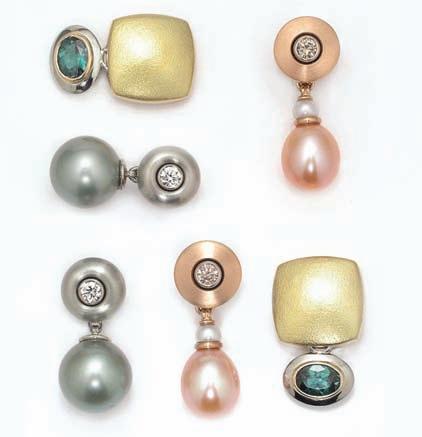
This lively new Indian restaurant opened at the end of February but already had a hopping lunch crowd only weeks later when I checked out the buffet for $14: eight classic Indian dishes, all well executed, as well as salad and dessert. I have a weakness for onion bhaji and the fried onion fritters, with coriander and cumin in the batter, didn’t disappoint. The curry pakoras were especially interesting with their slightly sour note thanks to a yogurt base, a nice contrast to the sweet creaminess of the butter chicken. The only dish I missed on the buffet was at least one that was spicy hot—everything was mild or gently medium. Even the beef vindaloo was medium, though plenty of ginger and garlic bolstered the flavours. It is worth adding a coconut lassi for $4, or a chai tea for $2.50. I have to admit I raised a wellshaped eyebrow at the receptionist’s Tim Hortons cup plunked by the cash when
there was chai to be had at her place of employment. But, hey, you can’t roll up the rim to win on china cups. The restaurant brought me back onside with its burfi, a traditional mix of condensed milk, sugar and often chickpea or nut flour. It can often be too sweet for me, but here the cooks cut way back on the sugar, and I enjoyed it much more. Don’t forget to try the desserts, which are also less sweet and syrupy than traditional Indian recipes. The Saffron Kheer Rice Pudding was redolent of cardamom and pleasantly creamy. More desserts are available at a deli counter.
A final note, if you order off the menu for lunch or dinner, you will notice prices range from $10 to $14 for vegetarian items, and $16 to $17.50 for meat. Do try the complex and tender goat curry—it’s a standout.
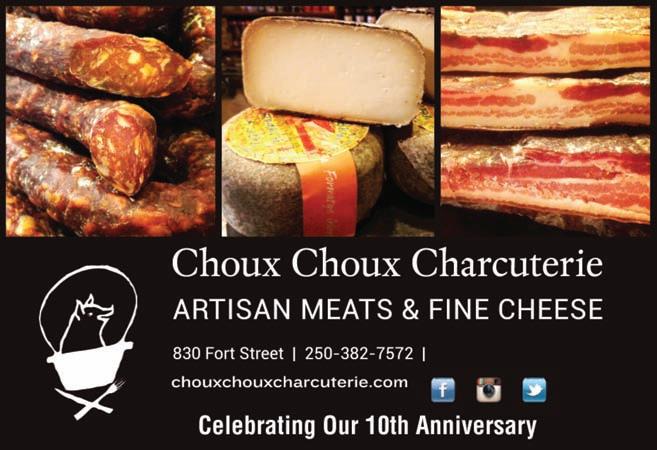
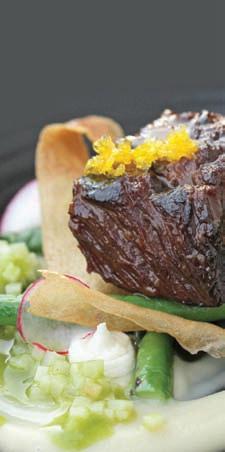







CANOE’S EXECUTIVE CHEF LUKAS EXELBY TUCKING INTO HIS BURGER WITH AGED CHEDDAR, BREAD AND BUTTER PICKLE, TOMATO, ORGANIC GREENS AND HOUSE SAUCE.
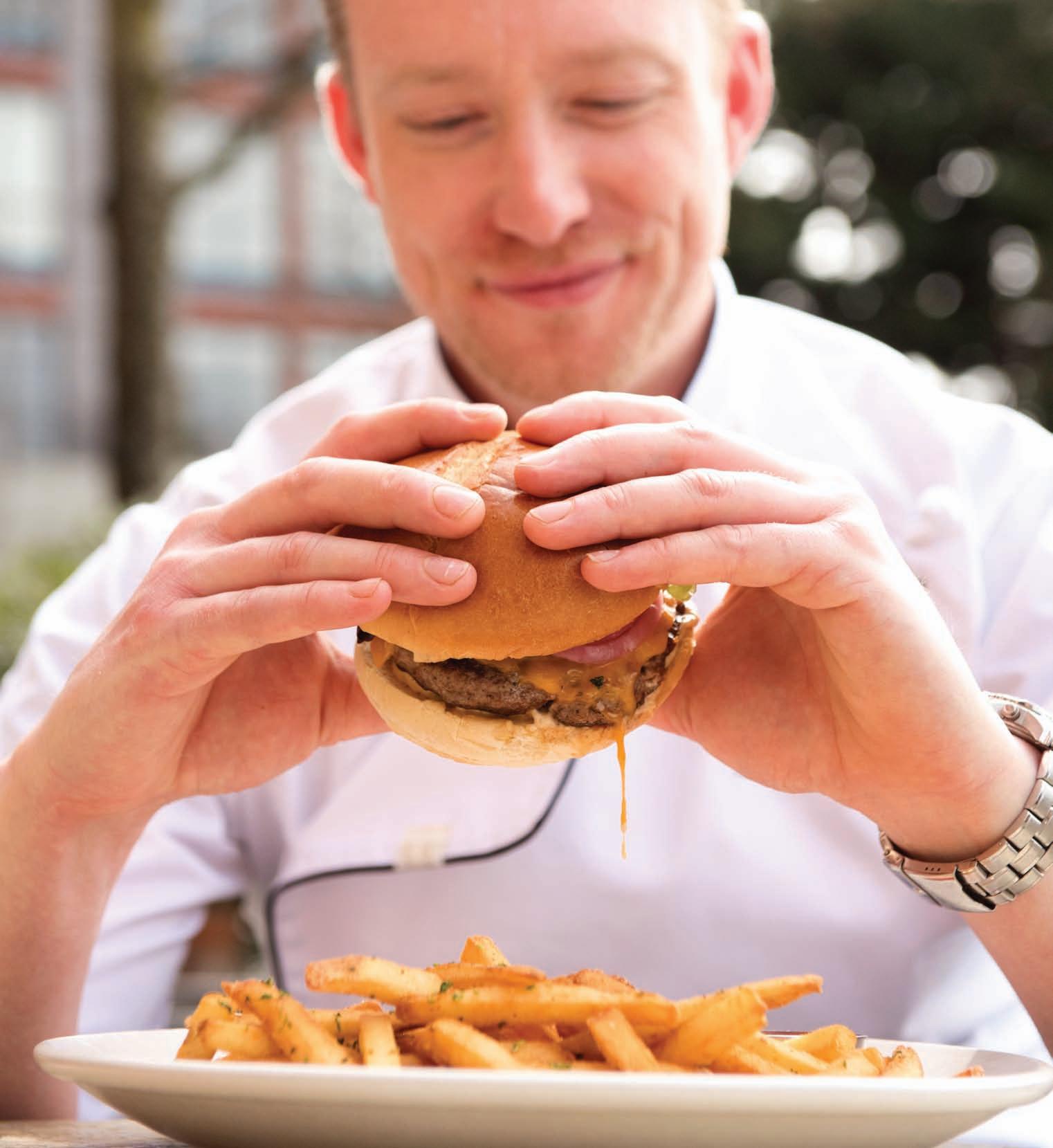
Five under-appreciated, unexpected and unknown burgers on menus around town.
In a sense, a hamburger patty is a lot like an uncontained sausage. It’s ground meat with spices and binders. Put it in a casing and you’d have more or less the same as any other link, but mold it into the shape of a thick, small Frisbee, bookend it with bread, add some sauces and maybe some cheese, and you’ve got something entirely different in your hands. You’ve got a hot meat sandwich that is consumed by millions every day around the world. McDonald’s alone sells 68 million burgers daily, which some people (mostly the executives at McDonald’s) claim accounts for almost one percent of the world population. That creepy clown is practically keeping the human race alive–but that is not the kind of burger we are talking about today.
The point is that burgers are popular for a reason. They’re a way to feed cranky kids in the backseat of cars without having to unload the crew. Even though most of us do our hunting in the meat coolers of our local grocery stores, grilling on a barbecue evokes the sense of cooking meat over an open flame during our hunter-gatherer era. They’re part and parcel of summertime, beaches and feeding a large group. In a very real way, they’re the anchor for so many good times that it’s almost impossible to find someone who doesn’t have some kind of affinity for them. Even the vegetarian and vegan crowd have their versions of the cornerstone treat.
Whatever your reason for loving them, there is no shortage of places to eat a burger in and around Victoria: Big Wheel Burger, Pink Bicycle, Bin 4—they all do an amazing job and should not be overlooked in an article about burgers. But there is also no shortage of articles about burgers in
After nearly a decade of vegetarianism, I went back to eating meat. That was eight years ago, but I can still vividly remember the first burger I had. It was the second piece of beef I was to consume after my hiatus, and it was an emotional experience. The familiarity of that burger—a nostalgic taste of post-hockey concession treats I had as a kid—transported me back to the memory of peeling a sweaty paper foil wrapper off the edges of a burger so I could drown it in mustard and ketchup. I felt the primal rush of using my hands to eat a meal that was made of cow. I got lost in the senses, closed my eyes and slowly enjoyed every bite until it was done, which it turns out is a very weird thing to do on a first date. But never mind that.
Victoria filled with praise for those providers, and while I would never hazard to steer your burger dollars away from your favourite spots, I do think there are several under-appreciated, unexpected and unknown burgers on menus around town that deserve a little focus too.
But first, what qualifies as a burger for our purposes here? Simply put, we’re looking for the classic. Nothing stuffed with foie gras and soaked in bourbon for a month. No, we are looking at burgers that are a patty or two of meat on a bun, with lettuce, tomato, cheese and perhaps bacon or some other small addition. We want burgers the way they used to be: hot meat in bread. Also, to be fair, we are comparing some

But first, what qualifies as a burger for our purposes here? Simply put, we’re looking for the classic. Nothing stuffed with foie gras and soaked in bourbon for a month.”



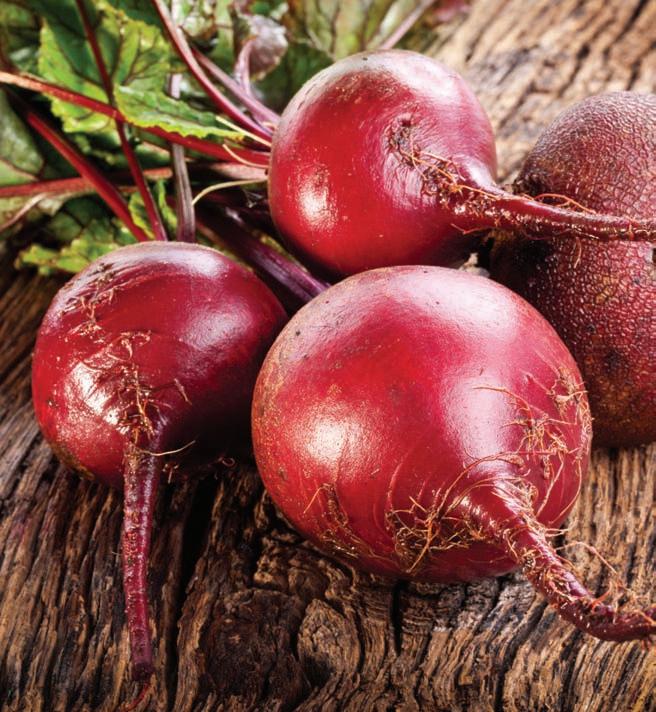
gourmet burgers with less “fancy” burgers, so the price point is going to be wide ranging. So do keep in mind that what I am writing about is the value and quality for its price. At the end of the day, I’d stand in line to get any one of these burgers, which fortunately isn’t often required.
To be honest, the whole purpose of this article was to be able to write about Red Robin burgers. I didn’t grow up with a Red Robin in my circle of available restaurants, so until a month or two ago, I’d never had one. I’d heard about them but assumed that some people loved them for the same reason they love The Princess Bride: because they experienced it when they were kids.









People who know this little place on Esquimalt Road love it for a reason. A Portuguese deli with a menu that boasts bifana (marinated pork loin with fried onions) and bacalhua (salted Portuguese cod), the burger here is handmade with authenticity and familial care. It is juicy, served on a fresh bun with lettuce, tomato and burger sauce, as well as hand-cut fries, soup or salad and a soda for $7.95. It might just be the best deal in the city.

Food truck burgers are hit and miss, but the team at Dead Beetz have found the secret sauce to making one that is truly of amazing quality. Local grass-fed beef patty with sauce, lettuce, Cheddar and truck-
Open 7 days a week
Fortunately, unlike The Princess Bride, which if you don’t watch until you’re an adult turns out to be a pretty terrible movie, the fandom of Red Robin burgers holds up. They are legit, flame-grilled and juicy. Easily my favourite burger in a long time for the price. They have dozens to choose from, but the classic Gourmet Cheeseburger comes with (for real) bottomless fries for a very reasonable $9.79.
“Unexpected” because the Brasserie is known for steak frites and other great French food (with a West Coast flair). But the skill in the kitchen runs deep and the burger being put out by chef Greg Ward is at the top of the gourmet burger ranks in Victoria. For 19 bucks, the handmade patty is perfectly balanced with just the right amount of fatty and lean meats. It comes with thick bacon, grain mustard aioli, Gruyère cheese—and the famous frites. It was once a part-time item on the menu that has become a constant.
made pickled beets, you can double your meat for just $3. At only $10, this burger will sustain you through whatever event you’re attending. Whether it’s Beerfest, Rifflandia or any other crowded affair, the experience of a Beatrice Beef Burger will keep you on your feet long into the night before you need to return for a second to save you from a long morning.

There is the argument that because my first burger after being a vegetarian happened here, I might have an unfair bias, that that first bite built in me an unshakeable solidarity toward this burger. It might be true, but you can’t kid yourself and say that this isn’t a great burger. The second most expensive on the list at $17.50, it is made with aged Cheddar, bread and butter pickle, tomato, organic greens, house sauce, fries or a baby lettuce salad. I’m convinced this is worth it, especially when you consider the location: drinking craft beer on the water in the summer and mowing down what is a fantastic—if nostalgic—classic burger.

Whether it’s Beerfest, Rifflandia or any other crowded affair, the experience of a Beatrice Beef Burger will keep you on your feet long into the night.”




















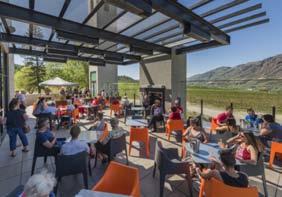








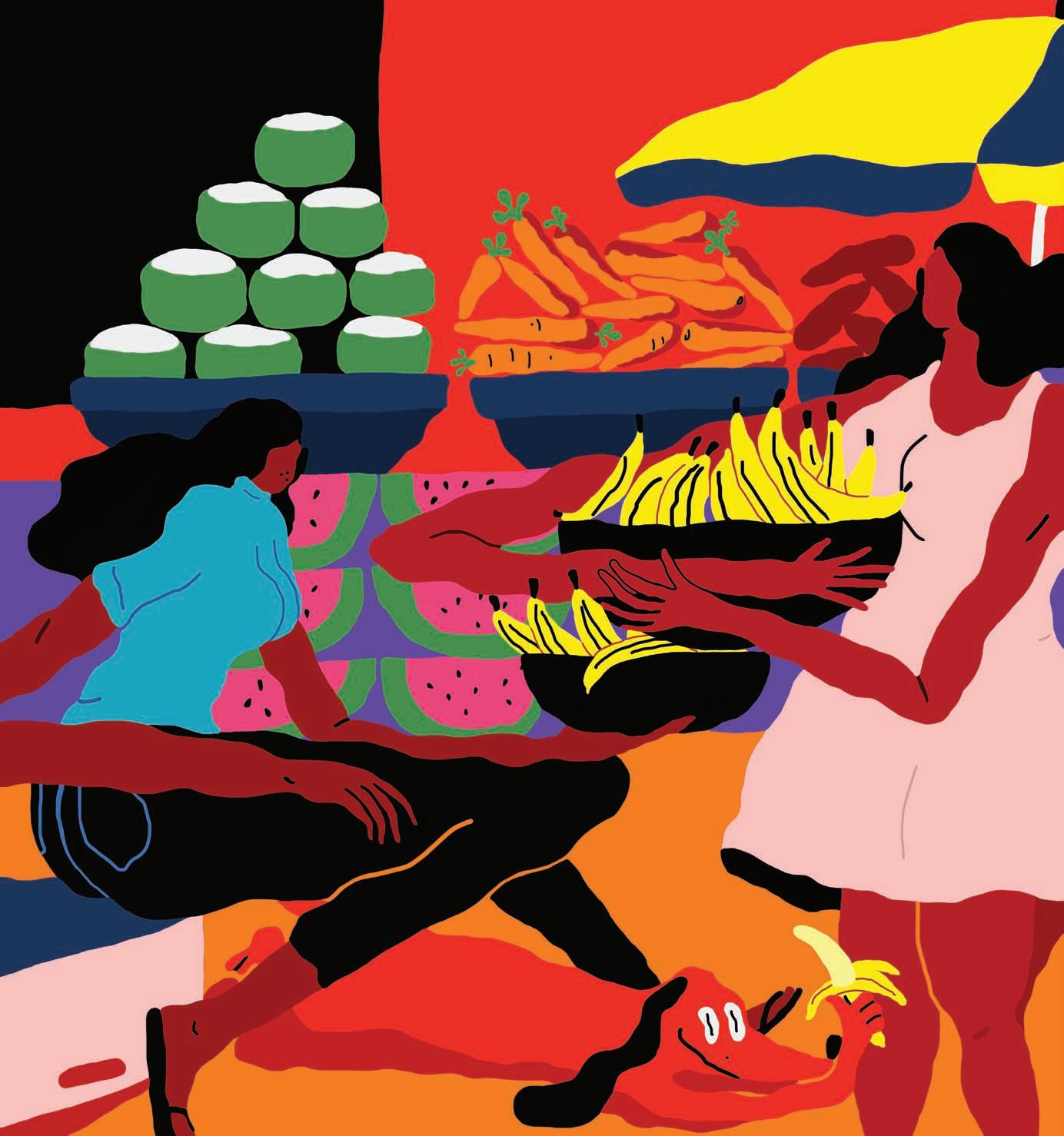
WHY DO WE TRAVEL? It has to be more than just trying to escape the yawning stretch of grey cloud cover that plagues us like an apocalyptic dream. For me, travelling is about getting out of my little box in my little city to go and see how other people live their lives, to see what it’s like to live in different environments and experience an alternate reality to my own. That, and to get away from all of you guys. At its core, travel gives us a view into what it’s like to simply be a human under different conditions. And one thing, in my opinion, more than anything else, will get you to the heart of a culture and give you a deeper insight into how that society functions and what its people value. It is their food. Food connects us to a place. It is how we imbibe a culture, a way of life and a social experience.
This is a travel primer on how to find as much adventure in your food as you do in the sights you see. It will mark your travels by providing context and cultural insight that you just can’t get hiking up a mountain or sunning yourself on a beach. Now, if you are a life-long resort-goer or cruise passenger, I want you to pay very close attention. If your thing is 15 different varieties of cake cut into two-inch squares, cheese platters coloured only by orange and white and access to bottomless neon drinks, good on ya, but my goal here is to get you to leave the buffet table and the 24-hours sundae bar far behind. If I can get just one die-hard all-inclusive tourist to march out to a street food stall and bravely bite into a stick of meat they know not from whence it came, my goal will have been met. For those of you already on the adventurous side but prone to sticking close to the downtown core and venturing out only on the recommendation of other tourists, this will hopefully get you out a bit more on your own and encourage you to trust your instincts. If you are a hardened traveller and you think you know it all, well then we’ll have some laughs together along the way. Because if you eat like me, you know that despite all the fun we have, there are more than a few pitfalls. i
OK, THIS IS PRETTY BASIC but knowing what you want to do and where you want to go can prevent you from wandering aimlessly around a city or town asking questions of people who do not understand you and most likely do not have time for you. Start with a simple Google search to find out what the national dish is, what fruits and vegetables are common and what the street food looks like. I love checking out food bloggers from the country I’m destined to visit. Often they will provide insight into what
people eat at home, favoured dishes and what spices and seasonings are used. Pages like Yelp and TripAdvisor can be useful, but be aware that reviews are often written by other travellers and can simply lead you to Western-style restaurants, particularly if you’re travelling to a less developed country. However, I can tell you from experience that when you’ve had enough goat stew, this can be the place to find a decent pizza. The Lonely Planet guides can be pretty good if you’re planning on travelling around a country. I tend to road trip and move around a lot, and finding a restaurant or bakery straight out of those books has led me into the neatest corners of whatever city or town I have just landed in.
Furthermore, Lonely Planet almost always lists local markets, one of the most essential destinations for any trip. When you arrive, start conversations—even if there’s a language barrier. It is incumbent upon you to pick up a few useful phrases of the local, which can initiate a conversation in broken languages. Ask your cab driver, your rickshaw guide, the cleaning person or the liquor store clerk: “Where do you eat?” This can lead you to all sorts of fun places that you never would have considered eating at. Doing research in advance gives you a plan of action; it frames your adventure but also allows you to act with a sense of purpose once you reach your destination. Google “where do I find?” and “what is this?” in the local language. Write it down. Use it.
BEFORE I EVEN TAKE A STEP off a plane I know where the local market is, what days it is best to go and what basic commodities are sold. I have mostly travelled to developing countries such as Uganda, Mexico, Nicaragua and the Philippines, and I know that much of daily life revolves around the market economy. It’s where people make a living, where they exchange news and gossip and where people go to get basic staples. This is where you’ll see the life of a culture and come to at least a basic understanding of how people live, survive and thrive. Markets, particularly in developing countries, are intense and the deeper you venture into the heart of the market, the deeper you are venturing out of tourist territory. Staying on the periphery is safe because you can always melt back into the crowd on the bordering streets if you start to feel overwhelmed. Be brave. Go deep but stay respectful. The market isn’t a tourist playground. This is the heart of people’s daily lives.
A travel primer for the adventurously curious and the curiously adventurous.
On my second day in Kampala, Uganda, I followed the guidance of The Lonely Planet and set out to explore Owino, East Africa’s largest open-air market. As I soon discovered, despite being in a reputable travel book, this was not a place for foreigners. Owino is sprawling, densely packed and has no rhyme or reason to its layout save for being enclosed almost entirely by rundown, fourstorey buildings. The deeper you go, the less daylight you see. It was 35 degrees and I was wrapped in an oppressive heat I had never before experienced. This was my first time on the continent of Africa, and I had just disembarked from a sketchy motorcycle that sat the driver, myself and a friend. As we wove our way into the market, we had to make a decision—turn left or right. We chose right. Or wrong depending on how you look at it. We found ourselves surrounded by blood and guts. Heaping mounds of glistening offal lay baking in the midday sun. Hooves, tails, snouts and rib cages were displayed in grotesque akimbo like a daytime house of horrors. Flies hummed far too loudly. My head swam as I started to drown in the smell. I raised my camera to my eye, pointing it at a butcher with a rusty machete. I slowly put it away after he violently jabbed his machete at me and screamed in anger (and rightly so). I now understood where I was and how I had to behave. Stay small, stay quiet, stay observant.
That said, Owino was my introduction to Uganda and taught me so many of the rules I was to follow over the next six months. How to greet people, how to haggle, when to engage, when not to engage, and, most important, how to eat. In the heart of the market was a food court of sorts. This is where market workers ate their breakfast, lunch and dinner. This was where I had my first Ugandan meal. It wasn’t good. It was meat boiled beyond identification, tarot root, matoke and dirty rice. But I was in the heart of the market as a voyeur and the least I could do was buy a hot meal from the hard-working women who kept the engine of the market purring.
Feeling more comfortable afterwards, my friend and I picked out different unfamiliar fruits and vegetables to examine, dissect and eat when we got back to our little hotel. My experience in Owino, and my subsequent ventures back into the market, provided me with a foundation of how to interact with people in Uganda. I learned the names of essential foodstuffs, what I liked to eat and what I didn’t like to eat. I learned how to simply exist alongside a culture to which I didn’t belong without overstepping, as we tourists are often wont to do. Go to the market, keep your mouth, hands and camera discreet and watch carefully. The market is the heart of every foreign city I have travelled to and the wealth of knowledge and experience you can acquire will be found amongst its fishmongers and farmers. i
OK, MY ADVENTUROUS ONES, it’s time to get weird. Street food stalls are the punctuation of most of my travels. The exclamation points, the question marks, and
the inverted commas. I remember cities, highways, villages and back alleys only by what type of street food I ate there. My memories are filled first with smell and taste, and followed only by what I might have seen.
EAT IT ALL. This is where my favourite rule comes into play—eat anything at least once. For example, I ate a barbecued chicken head because my husband likes to test my commitment to this rule. Outcome? I went back for more. Crunchy and spiced on the outside and an explosion of delicious fat (yes, brains are fat) on the inside. Just don’t think about it too hard! In my travels, I have discovered wonderful fried cheese snacks from a family on a deserted
local population has good literacy and Internet access, consult websites because locals will have been active on sites like Yelp and TripAdvisor. Guidebooks are OK, but they can’t keep up with the pace of restaurants that open and close on a dime. Main streets or tourist’s strips are a big no-no in my books. Almost every sizable city will have a main strip that is designed to entice unwitting tourists with cheap drinks, 2 for 1 specials or set menu deals. AVOID. Prices tend to be jacked up, the food is always mediocre and you have just chosen to hang out in the prime pickpocket area. This is also the place where you are most likely to get hounded by aggressive jugglers, menacing human statues and greasy men holding exotic
road in northern Nicaragua. I became enamoured with Rolex, a favoured East African street food consisting of a sort of crèpe stuffed with eggs, cheese, onion and peppers. My husband delighted in what he thought was pork cooked over a makeshift grill made out of a fan cover. I decided not to tell him it was intestine. You will make all sorts of discoveries and you will learn to like things you never dreamed of. Yes. You will make mistakes as I did with balut. You’ve heard of it, perhaps. It’s a still-developing bird embryo in its shell. My stomach still turns cold when I think about it. Will you get sick? Maybe. I’ve been blessed with an iron stomach and have never yet had a three-day affair with my hotel bathroom. But that said, you are just as likely to get sick from resort food as you are from street food, so just stay prepared. Find out what might be used in that country for gastrointestinal distress and keep it on hand if you are skittish. And at the very least, you’ll have an interesting story to tell.
AFTER THE LOCAL MARKET, a local grocery store or convenience store is where you will find all sorts of amazing local delicacies: interesting cereal, cuts of meat you’ve never seen before, delicious baked goods and chip flavours that should never have been considered for a chip. The candy can be a trip and, depending on where you are, might be intensely salty or insanely spicy. One of my absolute favourites is Skwinkles Salsagheti. The gummy red strings with a spicy coating come with a packet of salsa-flavoured sauce to go on top. It’s candy. It’s spaghetti. It’s salsa. It’s Salsagheti. If you’ve travelled around Mexico, you know what I’m talking about. If the market is too much for you, hitting the local grocery store will still give you a reasonably good picture of the local cuisine without the intense humanity that comes along with perusing the markets.
When looking for restaurants, a travel guide or website can come in handy depending on where you are. If the
baby animals that will break your heart.
My best advice is walk around the city or town and scope out where the locals are, what looks good to you and what piques your interest. Better yet, get out of the downtown core altogether. Go to different neighbourhoods or nearby towns where people actually live. Eat at a cantina, buy street food from the open door of someone’s house or get your cab driver to drop you at his favourite place. That’s how we found ourselves at the doorstep of Mari’s house ordering a mysterious dish called The Rundown while on our honeymoon on a small island off the coast of Nicaragua. Our cab driver, David Taylor, boasted that the stew-like dish, consisting of breadkinds (starchy vegetables) conch, lobster and fish would either knock us out for a full 24 hours or result in three days of sexual ecstasy. I won’t reveal the full effect of The Rundown, but I will tell you we did make our 7 a.m. flight the next morning.
At the end of the day, travel is about adventure, discovering new and exciting parts of the world and gaining insight into how other people live their lives. Food is such a large part of how we understand the world around us. It is how we get to know one another, how we connect with both friends and strangers and how we provide context for lasting memories. The process of seeking out and discovering new food will bring the adventure to our doorstep. We will find ourselves in the most unlikely of places with the most unlikely of friends where we will acquire the most outlandish of stories that will mark our adventures as truly unforgettable. And if nothing else, when the wine is not inducing conversation and everyone is bored out of their minds at a subpar dinner party, you can always pull out the old “Hey, did I ever tell you about the time I ate a chicken head?” It works every time.
“YOU ARE JUST AS LIKELY TO GET SICK FROM RESORT FOOD AS YOU ARE FROM STREET FOOD.”

which was the size of a baseball, and was served with an orzo salad with basil vinaigrette on the side. I’ll have to try their sandwiches some other time.
On a Friday, I tried Greek on the Street, where I had a generous Greek salad made with very fresh vegetables, a pork souvlaki wrap, and a hearty, plump spanakopita. The trucks at this site offer a range from traditional choices to multi-ethnic ones. Grilled to the Mac features grilled cheese sandwiches and macaroni and cheese but also features a grilled sandwich with mac and cheese in the middle if you’re looking for a twist. The Rolling Reef offers more exotic choices like Plantain Chips with Jerk Mayo, and West Indian curry. The trucks have enlivened the food scene in the Jutland area.
On Wednesdays and Fridays, food trucks can now be found at lunchtimein the Robbins parking lot on Jutland Road at the Selkirk Waterway, an area where offices—and office workers—abound and beautiful benches line the Gorge Waterway where you can enjoy your food. For now, there are ten participants sharing the one spot: L’Authentique, Hungry Rooster, Greek on the Street, The Crispy Fish, Pepperman’s Grill, The Rolling Reef, Dead Beetz, Saltchuck Pie Company, Grilled to the Mac, and Indecent Risotto.
On a Wednesday, when I checked out Indecent Risotto, which I can assure you was in fact more than decent, I enjoyed a deep-fried ball of risotto stuffed with four cheeses, called an arancini,
1715GovernmentStreet
250.475.6260
www.lecole.ca

eat@lecole.ca
Dinner5:30-11pm
TuesdaytoSaturday
But a big a part of food trucks is the conversations that go with the food. One government employee, Drew, said, “Food trucks are funky; they bring the Jutland office community together.” And interesting conversations can be had with food truck staff as well. I was surprised to find myself being served risotto by the current president of the Island Chefs Collaborative, Andrew Paumier. And in the Greek on the Street truck was another veteran of the Victoria restaurant scene, Kostas Calfoutzos, who owned Periklis restaurant for decades.
So at the Jutland food trucks, you might encounter a new kid on the block, or you might get a chance to try some classic Victoria food. Check out the Street Food App Victoria to find out which truck comes which Wednesday or Friday to Selkirk Waterway and more. (streetfoodapp.com/victoria)

These burgers are a meld of some of the most tastes creates a balanced combination of sweet,

popular Asian flavours found in pot stickers, Banh Mi sandwiches and spicy wasabi. The layering of these distinctive eet, savoury and spicy in every bite. Double the patty or serve as a single burger and add garnishes as you please.
Makes 6 burgers. For the patties
500 g or 1 lb ground pork
150 g or ⅓ lb prawns, peeled and chopped
2 cups shredded cabbage
2 Tbsp soy sauce
2 Tbsp red wine
1 Tbsp sesame oil
2 tsp ground fresh ginger
2 cloves garlic, crushed
1 Tbsp anchovy paste
1 cup panko or breadcrumbs
To make the patties
Combine all ingredients in a large bowl, let mixture rest 10 minutes or refrigerate till ready to use.
With your hands or a hamburger press, shape the meat into six patties.
For the Bahn Mi slaw
½ cup rice vinegar

¼ cup sugar
¼ cup water
1 cup finely sliced daikon radishes (lo bok)
1 cup finely sliced carrots
1 red onion, finely sliced
To make the Bahn Mi slaw
In a small saucepan, combine vinegar, water and sugar, stirring well. Cook over medium-high heat until the sugar dissolves, about 2 minutes; let cool.
Combine daikon, carrots and onion in a bowl. Add the vinegar mixture and refrigerate 30 minutes.
For the Avocado Wasabi Aioli
½ cup of mayo
1 avocado
½ - 1 Tbsp wasabi paste
¼ cup fresh cilantro leaves
1 garlic clove, crushed Juice of one lime
To make the avocado wasabi aioli
In a small food processor, add all ingredients and puree until smooth. Refrigerate until ready to use.
Garnishes
Pea shoots, optional Halloumi cheese, optional
To make the burgers
Preheat the grill, setting the burners to medium-high. Oil the grate.
Grill the patties for 3 to 4 minutes on each side, or until an instant-read thermometer indicates a Food Safe internal temperature of 160°F (70°C). Toast the buns, if desired.
For a single patty burger, spread aioli on
the bottom half of the bun, then layer with garnishes, if desired, a patty and slaw. Close with the top half of the bun. For a double patty burger, spread aioli on the bottom half of the bun, then layer with pea shots, a patty, cheese, another patty and slaw. Close with the top half of the bun.
Serve with pickled beets and shrimp crackers and your choice of buns or wrapped in lettuce leaves for a glutenfree option.
Pair with Sea Cider’s Kings & Spies cider or Salt Spring Wild’s pear cider
THE B.C. COAST. He also loves his Italian roots and Italian food culture. As chef de cuisine and right-hand man to executive chef Terry Pichor at Villa Eyrie Resort’s Summit Restaurant, Ingham has found a perfect kitchen for his twin passions.
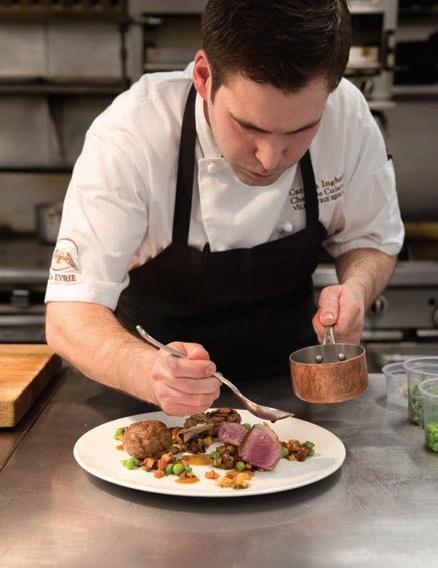
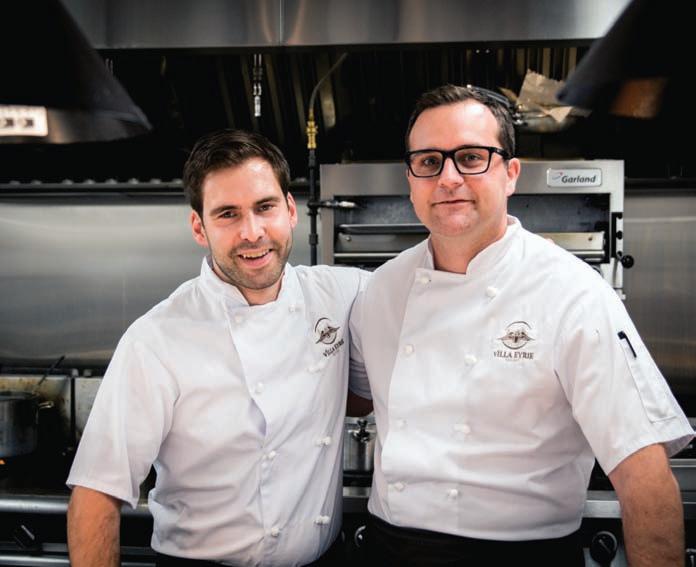
“When Terry told me that the concept for the restaurant was to be inspired by coastal Italian cuisine while using all local, fresh ingredients, it was an easy decision to join the team.”
Ingham has been working in kitchens for 12 years since finishing high school at St. Thomas Aquinas in North Vancouver. Immersing himself in a broad range of cooking environments, Carmen worked in small hotels and restaurants throughout Vancouver and the Gulf Islands.. “I’ve done a lot of staging, notably at Bearfoot Bistro in Whistler and Hawksworth in Vancouver. The best and most influential one was Willows Inn on Lummi Island, Washington,” Ingham explains. “Willows Inn was a big influence on the way I like to use some of our wild, local ingredients.”
Most recently, chef Ingham spent four years at Sonora Resort, two as sous chef with his current executive chef Terry Pichor. He calls it “the most impactful place” in his 12-year career and “an enlightening time for me.” It ended up strongly dictating the way he cooks today.
“Cooking at Sonora was always really connected to the resort’s environment. Having the inspiration of working in such a beautiful, small island environment is something I would always like to have in my life, and that was a big draw for me to come work at Villa Eyrie with Terry. At Sonora, my walk to work would be five minutes along the water, and I would always stop to pick different berries, blossoms and sea vegetables to finish the plates with.”
One of Carmen Ingham’s biggest influences outside of the B.C. coast was the two months he spent in Italy, first visiting family in Genoa, then as a WWOOF apprentice/stage at a small agriturismo just outside Lucca in Tuscany. Working at the farm with a little inn and restaurant attached, chef Ingham spent the mornings picking olives and tending vegetables and the afternoons in the kitchen preparing dinner service for the 12-seat farmhouse restaurant.
Ingham has fond memories of his time in Italy and is very excited about the chance to combine the flavours of the Island with an Italian-leaning menu at Villa Eyrie. “We have been really enjoying getting to know the different farmers and purveyors on the Island. Lockwood Farm eggs have been a mainstay for us, as is Saanich Organics for fresh produce.”
“We’ve been working with Lance Staples, a local forager.
Spring is really when wild foods are at their peak here as far as diversity goes. So we’ve been really excited to see his weekly delivery. Spring produce is something we have been looking forward to for a while.” Ingham winces at the memory of this year’s extended cold and snow. “There have been so many small farms that have been approaching us with great produce to offer that we are spoilt for choice. Our menu changes often with our family-style menu changing daily. So we’re able to buy whatever looks great on a daily basis from around the Cowichan Valley.”
English peas have always been one of chef Ingham’s favourite ingredients. This spring he’s using them in a classic pairing with mint and lamb. “Lamb with Sicilian eggplant caponata is another great combination,” the chef enthuses. “Adding all those elements together results in a well-balanced dish that really reflects the concept of this restaurant at Villa Eyrie as well as showcasing some beautiful, local products.”
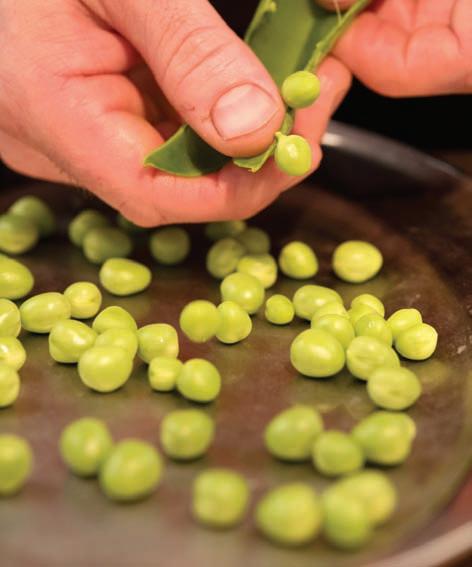
The Summit Restaurant at the Villa Eyrie Resort 600 Ebadora Lane, Malahat, 1-250-856-0188 villaeyrie.com
info@villaeyrie.ca
This recipe combines the English affinity for peas and mint with the Sicilian classic, caponata, for a versatile side dish that is ideal with spring lamb.

INGREDIENTS
300g English peas, shucked
300g eggplant, diced small
100g red onion, diced small
80g Sultana raisins
50g capers
150 ml San Marzano tomato sauce
4 cloves garlic
75 ml Balsamic vinegar
250 ml olive oil
50 ml grapeseed oil
1 Tbsp fennel seeds
1 Tbsp oregano
1 Tbsp crushed chili
1 bunch fresh mint
Kosher salt – to taste
Lemon juice - to taste
This spring we wanted to focus on using locally sourced proteins on the menu as much as we can - specifically Parry Bay Farm lamb, from Metchosin. The challenge is to ensure that we’re utilizing the whole animal and building dishes around the cuts that aren’t as common at butcher counters. We’ve opted for a mixed menu that showcases a variety of different dishes and price points across breakfast, lunch and dinner. This allows us to do duos of rack with a house-made lamb sausage, sirloin with grilled breast, saddle stuffed with grilled neck meat, or roasted leg on our family-style dinner menu.
As we’re now starting to see the nice spring weather, lamb burgers or grilled lamb sausages will be a perfect choice for a light lunchtime option. Working with the whole lamb is an experiment, and we’re hoping to do something similar with locally sourced whole pork and sides of beef as well.
The other item I’m excited about is all fresh, local vegetables for our spring menu. This is my first summer at the Summit Restaurant and I’m really looking forward to seeing what’s out there from growers we currently purchase from, such as Saanich Organics. We’ll also be trying out other local suppliers, like the all organic Code’s Corner Farm in Duncan. We get foraged wild goods from Lance Staples and we’re starting to harvest from our new 30ft on-site greenhouse. The end goal is a small hobby farm here at the Villa Eyrie Resort, as we already have chickens and ducks on the way!
We’ve also begun planning for this year’s Mother’s Day Brunch. My mom, Cheryl Pichor, has made it possible for me to be who I am, our family is very close even though we are living halfway across the country from each other. Her greatest skill was to encourage me to find my own person and independence and she’s the inspiration for my special Mother’s Day Brunch. It is going to be a fun family affair with lots of spring-time-inspired sweet and savoury options on the buffet. At the carving station we will have a bit of an Italian influence and a porchetta carved to order.
Mother’s Day Brunch Buffet at the Summit Restaurant will be served May 14 from 10:30am to 2:00pm. For reservations please contact the restaurant at 250 856 0188 or book online at www.villaeyrie.com/summit-restaurant.
SERVES 4 AS A MAIN COURSE
METHOD
Place the olive oil, garlic cloves, chili, fennel, and oregano in a small pot and heat gently until the garlic is lightly browned. Strain the oil and discard the solids.
In a small container, add the balsamic vinegar to the raisins to rehydrate.
Place a wide bottomed pot on high heat, add the grapeseed oil, and sautée the eggplant until lightly charred, and remove the pot from the heat. Add the red onion and season with kosher salt. Add the tomato sauce, olive oil, capers, raisins, and balsamic vinegar and allow the mixture to infuse at room temperature for one hour before chilling and placing in the refrigerator. This can be done up to two days prior to serving
Blanch the peas in salted boiling water for 2 minutes until tender. Meanwhile heat the caponata in a small pot. Add the blanched peas. Chiffonade the mint and stir it in at the last minute. Adjust the seasoning with kosher salt and lemon juice, if necessary.
First Course
Saanich Organics Salad, mint, rhubarb, huckleberry, almond, sorrel vinaigrette Market Crudo, daily changing garnishes
Grilled Asparagus Salad, Lockwood duck egg yolk, lemon aioli, radish Salt Spring Island Goat Cheese Sformato, aged balsamic, wild mushroom conserva, green garlic, wild greens
Octopus Carpaccio Giardino, pea greens, carrots, radish, pork sausage, artichoke, Calabrian chili vinaigrette
Pasta Course
Spring Onion Risotto with Braised Rabbit, mint and ricotta salad
Nettle Ricotta Agnolotti, garlic butter, black trumpet mushrooms, oregano
Pea and Spot Prawn Gargenelli, English snap pea tendrils, prawn butter
Chicken Parmesan Cannelloni, Natural Pastures buffalo mozzarella
Main Course
Spring Vegetable Ribelita
Chinook Salmon, artichokes, fava bean farotto, Summit garden pesto
Halibut, peas, Swiss chard, pea and guanciale vinaigrette
Smoked Cornish Hen, early summer beans and legumes, basil, tomato and chili
Brant Lake Waygu/bone-in New York Steak, rosemary, lemon-roasted sunchokes, wild mushrooms
Parry Bay Lamb (rotating cuts) eggplant, fennel, mint caponata
Vegetables
Carrot, lemon Eyrie garden mint, ricotta salad
Boiled New Potatoes, parmesan, black pepper, crema, chives
Spicy Beans with Nota Farm honey, house-dried chilies
Spring Green Panzenella, ciabatta bread, fennel vinaigrette


















WHAT IS VICTORIA? Are we a city or a town? We certainly aren’t a big city, but we ain’t no little town neither. Some days Victoria feels big, as if there are endless possibilities for new and interesting activities and adventures. Other days it feels so very small, as if I can’t go anywhere without bumping into someone I know from high school. Haven’t I been everywhere and done everything here? In my head I’m just screaming to get out and explore a big bustling city where I can remain anonymous, free of the same old same old. I suppose, like most things, it depends. Ask me on a rainy Monday and I’ll probably say “small town.” Ask me on a warm Saturday afternoon in July and I might say “city.” The answer is, it is both and that’s what makes Victoria a wonderful place to live. We are ever-changing, always updating and shifting towards the future with a strong sense of where we came from.
The neighbourhood that epitomizes our big town, small city complex is The Lower Harbour District, or LoHo as I’ve dubbed it—the area from Douglas Street to the waterfront, between Humboldt and Yates. This area is in constant change: new stores, the latest restaurants, old favourites and timeless haunts. It’s a meeting of time and history, of locals and tourists. Somehow we need to keep it our own, but we also need to remember that this area is the extent of what many tourists are going to see of our fine city. Somehow, this ongoing battle works for us. Lower Harbour brings together a
By Jill Van Gyn












perfect blend of our touristy side and our local side. We locals can blend seamlessly with visitors and often secretly revel in how busy and vibrant this district looks and feels in the summer months. It might remind us that there’s a reason why BeaverTails stays steadfast and busy year-round in the heart of the district: tourists love the quintessential Canadian fare—but so do we. The wonderful thing about this neighbourhood is we can head out for a night on the town and rub shoulders with familiar faces but hit different hot spots that have all the trappings of a big city. We might drop by Bodega early on for some tapas, head out for a show at a local club then top it off with a killer cocktail at Little Jumbo just before the clock strikes 1 am.
Yes, Victoria can get boring, but the longer I live here the harder it is to imagine living anywhere else. Many of us moved away for a time, whether it was Vancouver, Toronto, Montreal or some other great city. We’ve taken our chances in a bustling capital and lived to tell the tale. Yet we come back. Victoria, if you were born and bred here, raises adventurers. We grew up in the outdoors, heading off to some remote beach at the drop of a hat for a last-minute camping trip where we sit up all night drinking Fireball till the early hours. A phone call comes and we’re off to the lake rigging up a rope swing or hurling ourselves off a cliff that has a stern warning sign at the top. This is a town built to inspire road trips, a “let’s get out of here” mindset. The phrase “I’m in” rolls easily off our tongues.
This might be why our city is as dynamic as it is. And yet, after leaving the comfortable nest of Victoria for the wilds of sprawling cityscapes—we return. Why? Because we can’t live without the mountains, the ocean, the lakes and the ability to turn on a dime and just get out of the city limits for a while. But we can return to our downtown core, our familiar LoHo District, after we’ve had our fill, and feel we have options that might have been afforded in the big city. Like picking out a dainty selection of pastries from Bon Macaron to nurture memories of a summer in Paris. Or grabbing a big group of friends and hitting North 48 or Ten Acres for a lively and social dinner that celebrates wine and local ingredients. The area has thriving and long-standing restaurants such as Ferris’ Oyster Bar, Fiamo and Tapa Bar that make us feel as if we belong, that this is our big little city. Victoria has populations of creative, motivated and inspired people who have been to the big city, taken what they liked and transplanted it here, all over our mini metropolis.
The 10 Acres family includes three unique downtown restaurants along with our own organic farm in North Saanich. Offering something for everyone, each room is distinctly different however all are dedicated to serving local, sustainable and delicious food from the land and sea in friendly environments.

Our farm supplies 10 Acres Bistro, Kitchen and Commons with the finest seasonal and organically grown vegetables, orchard fruit, nuts and honey plus pasture raised pork, duck and turkey. At this time of year our farmers are busy planting and nurturing our crops for harvest (7.5 tonnes produced last year) in rich soils using our own compost (48 tonnes produced last year)!
What we don’t grow and ethically raise ourselves, we proudly source from other like-minded farmers, food purveyors and fishermen including Berryman Brothers Farms, Westholme Farms
and Hollie Wood Oysters. Our commitment to providing local continues through our diverse seafood offerings selected for their seasonal availability and freshness.
The Bistro with its rustic chic vibe and a cozy fire lit patio open year round, is our original farm to fork restaurant offering guests comfort classics for lunch and dinner as well as weekend brunch. The Commons is a welcoming space blending a modern, comfortable aesthetic with industrial accents. Our menu of everything from classic burgers and fish + chips to sushi and tacos along with local craft brews are just some of the reasons to come by and hangout. The Kitchen is passionate about providing guests with a slightly finer dining experience maintaining the same commitment to local offering truly unique menu items.
No matter what room you choose ... we pledge to satisfy your taste buds, serving the best of the Island!
Something draws us back into Victoria time and time again: the fact that it can be a small town or a big city depending on what we need it to be. There are days when we need it to feel familiar and warm and others when we need it to be new, exciting and fresh. Victoria can be either of those and it’s why we don’t need anything more but we wouldn’t settle for anything less. LoHo is the core of our city, the face of our town and the gateway to all the other lively neighbourhoods that reach out from downtown Victoria. Many of us view it as a tourist district, but we all know it truly belongs to locals. This is where the world comes to us, where we welcome people from every country on the map, and enjoy world class dining, a vibrant nightlife and superb shopping. It might be small in terms of square footage but packed into this tiny district is everything you could ever want in a big little city.
We talked to nine chefs who revealed amazing dishes that aren’t always menu favourites—but should be.
BY ADRIAN PARADISThere’s a certain comfort in going to a restaurant and getting the old staples. Often, a location becomes known for a particular dish because they do it often, and they do it well. But occasionally, the adventurous diner wants something off the beaten path. Scouring the less popular items on a menu can be extremely rewarding. You may even discover something you didn’t know you loved. To find those hidden gems, we asked eight establishments, “What’s your most underrated dish?”
Gabriel Fayerman-Hansen – Chef at Little JumboOur least ordered item tastes amazing and blows people’s minds when they have it: our squash risotto. I wanted to have a vegetarian option that wasn’t a lame pasta dish, so we developed this “parm” broth. We pop our grana padano parmesan rinds into cheese cloth, wrap them up tight and take the shiitake mushroom stems from our sablefish dish to make this fortified stock. We fold in squash puree as well as diced roasted squash with lots of winter herbs and finish with mascarpone cheese to give it a luscious texture. This is a dish with incredible flavours and textures, but it doesn’t get ordered as often as I’d like. Maybe it’s because we don’t have a crazy amount of vegetarians come into the restaurant.
For our spicy tuna tartar we use finely minced tuna belly and mix it with a Japanese hot sauce we make from Thai chilies, mango juice and miso. We mix that with green onion, mayonnaise and strips of nori, and put it on a crispy rice cake. It’s not that it’s less popular, but that dish has been with me since my Bistro 28 days, and it’s been one of my favourites for a long time. I think it’s one thing that should be flying out every night and sometimes it doesn’t. Most places may just go for a bottle of Sriracha, but we put a lot of time and effort into the chili paste we make.
People usually think of charcuterie as salami, terrine, pâté, but we’ve been doing seafood charcuterie in-house, making cured albacore tuna, carpaccio octopus, gravlax salmon and seafood sausage. It’s such a good dish—I love the flavours—but not everyone seems to be into it. People will eat smoked oysters or salmon on a regular basis, but we’re trying to do a prosciutto-style tuna. Those that have it rave about it, but not everyone is so adventurous. It makes the texture so much more interesting.
Mark
Brian at Bodega – The roasted mushrooms, lentils and kale is under the guise of being healthy, and it’s so delicious, but it’s also full of butter. People love it. Meat eaters are sometimes hesitant, but they always find it delicious. They go into it with some skepticism, but it’s still an indulgence.
Mark at Tapa Bar – Our coconut lime mussels are popular so people seem to steer away from the spice of the mussels de cha cha cha. The dish has butter, garlic, white wine and sambal so everyone thinks it’s going to be really spicy. But they’re actually some of the best mussels I’ve ever had, more peppery than spicy, and I like to sell them because it’s something different.
Mark Mebs – General Manager at BeaverTails Victoria
People that have tried our poutine love it. They become addicted. You wouldn’t think of BeaverTail as having great poutine because of our main BeaverTail product, but our poutine is pretty underrated. You can get poutine at a lot of different places, but we get our cheese curds from Quebec and use a vegetarian gravy, which really is a nice surprise to those looking for a vegetarian-friendly option. When the cheese starts to melt, and they take a forkful with stringy cheese, fries and gravy, it’s the perfect combination.
The one thing we do differently from a lot of other places that serve macaron is we have savory flavours. The meringue is exactly the same, but the filling, instead of being sweet, is made with something like cream cheese or goat cheese. Those are used more as an appetizer or with a glass of wine before dinner. We host classes each week, and while the macaron are baking, we serve some savory macarons (bacon, blue cheese walnut or whisky, for example) with drinks like sparkling wine, prosecco or juice. For a lot of people, it’s the first time they’ve actually tried a savory macaron and they really enjoy it.
James Avila – Chef at Fiamo Italian Kitchen
Our feature sheet changes every two to three days and features our Top Soil organic program. So I think it is our most underrated dish. It’s something that is unique and changing all the time. We’re always working to put out our main menu, but we’re also trying to source and responsibly serve what’s in season and sustainable. I do our stuffed rabbit every two or three months on the feature sheet. I
No review of Victoria’s downtown restaurant scene would be complete without shining a light on North 48. Originality abounds at this eclectic modern diner. This family owned independent eatery has found a niche amidst the vibrant west coast food scene with their unique take on cutting-edge comfort food. Whether reviving an old classic, or putting an adult spin on a childhood favourite, Chef Sam Chalmers has only one criteria; does it make you happy?
This driving philosophy has led to the creation of a menu that seeks to satisfy both the belly and the soul. Chef Chalmers has drawn inspiration from North American Diners, Belgian Bistros, Japanese Izakayas and everywhere else in between. The result is a diverse menu that ranges from Sous vide Meatloaf with Cheese Curd Mashed Potatoes to French Onion Soup pressure cooked in a mason jar. Combine this with the west coast ideals of sustainability,
locally sourced ingredients, and house made everything, and it should come as no surprise that North 48 was recently named one of Canada’s best new restaurants.

The fun doesn’t end with the food at North 48. The regulars know that the best seats are at the Tiki Bar where contemporary comfort food and retro cocktails collide. You will be hard pressed to find another restaurant where you can soothe your soul with a plate of Chicken and Waffles, sipping The World’s Greatest Banana Daiquiri, while watching Saturday Morning Cartoons.
If you haven’t been to North 48, be sure to take advantage of their Weekday Specials. Tiki Tuesday, Burger & Hoyne Wednesday, and their super popular Duck Wing night called Buck-aDuck Thursday. Can’t decide? Come in on a Sunday, and have all three!
1005 Langley St, Victoria, BC 250-381-2428, northfortyeight.com
debone the whole thing, stuff it with thyme sausage, chicken, fresh basil and mustard, then roll it, wrap it in prosciutto and slow-roast it for 40 minutes.
Dave Craggs at Ferris’ Restaurant Group
I really like the tradition of fisherman stews, generally cheap cuts left over and then stretched with potatoes or bread. Thickening with nuts is uniquely Catalan and adds an interesting texture and flavour. Our version is Suquet de Peix, a Catalan fish stew with hazelnut picada. Like all great fish soups of the world, a fisherman’s stew is prepared with various fish and shellfish in a rich saffron broth, thickened with picada, which is a paste made from bread, garlic, parsley and nuts (in this case, local hazelnuts).
Twenty-one years ago, at a time when steak houses were in their prime, and chain-restaurant sized portions were the norm, Victoria’s first “small plates” restaurant was born. Inspired by the style of eating in Spain, and the flavours and culture of Latin America, the Tapa Bar opened in historic Trounce Alley with a menu of appetizer-sized dishes designed to cater to smaller appetites, and foster the spirit of sharing. The menu was embellished with pastas, pizzas and steaks, still created with sharing in mind, but large enough to be meals on their own. Before long the original menu had a tenacious following and has since undergone very few changes. The vibrant room animated by salsa music, continues to be a nostalgic mainstay for locals and visitors alike, for everything from romantic dates to gatherings of friends over tapas and wine.
In 2014 the Tapa Bar took over the space next door, and still driven to create an authentically Spanish tapas bar, opened Bodega. The small, intimate room where the kitchen and bar share the same space offers a very Spanish feeling experience. The rotating tapas menu is comprised predominantly of locally sourced, seasonal ingredients where possible, or specialty imports that showcase classic Spanish delicacies. The carefully assembled wine list is exclusive to Spanish grapes, and the Sherry list is unmatched in BC. It’s a piece of Spain in the heart of downtown Victoria.

1210 Broad Street, Victoria, BC 778-406-1210 bodegabar.ca
Walking into Fiamo Italian Kitchen on lower Yates St you’re struck by the warmth of the greeting. There’s a sense that the staff wants to provide genuine hospitality. Whether you take a seat at the long bar, a table in the brick-walled dining room or decide to wile away a few pleasant hours on the cozy outdoor patio, you won’t go wrong. Fiamo has built its reputation on great food, a warm and friendly atmosphere and a consistently excellent dining experience.
Husband and wife team, David Kindrat and Alyssa Carlson, opened Fiamo in 2008 with a goal of creating welcoming restaurant that’s more like a European bistro. A dazzling grand chandelier anchors the highceiling room. Warm exposed brick adds to the mood of decayed elegance. Upstairs on the mezzanine there’s space for private parties or celebration dinners, and the bar is well stocked with international wines and spirits. During the spring and summer season Carlson likes to add more BC white wines to list because she feels they pair well with the seasonal approach of the kitchen. Moving outside is the popular Fiamo patio (there’s a heater for cooler temps and a wind screen for breezy nights). Imagine being tucked into a cozy corner on a warm evening, a glass of house Prosecco in hand, nibbling on a plate of charcuterie while watching the world go by. It doesn’t get much better than that.
“The patio is an extension of our dining room”, says Carlson. “It’s so warm and cozy with candles and the lighting. People say it reminds them of sitting in a café in Rome”.
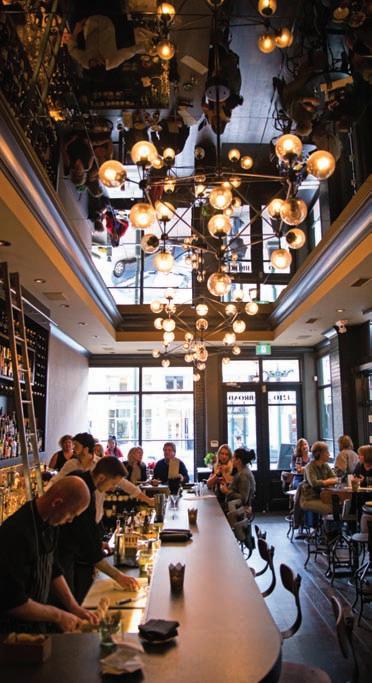
Chef James Avila heads up the busy kitchen and is a big believer of using local, west coast produce to underpin his comfort Italian/Mediterranean cooking. Most of their fresh vegetables come from the Topsoil program,

an urban farm less that a kilometer away at Dockside Green. There’s a zero carbon footprint as the farmer brings the day’s fresh-cut produce to the restaurant on his bike. “I love it when the basil arrives, the smell is beautiful and the flavour is remarkable.”
Asked what his signature dishes are Avila says his favourite is The Shaved Prosciutto thin-crust pizza with Chianti-braised figs, goat cheese and toasted almonds. Looking over the menu the Butternut Squash Ravioli stands out as well as the dinner sized salad of mixed greens, sautéed vegetables and garlic-fried prawns. Other dishes include the ever-popular meatballs in simmered in tomato sauce, seared tuna Tataki, grilled marinated Metchosin lamb chops and a beautiful grilled 6oz beef tenderloin. There’s also a daily fresh sheet that reflects the season. “We don’t serve frozen halibut,” Avila emphasizes, “so the fresh sheets allows us to have seasonal offerings.”
Fiamo is one of only a handful of restaurants in the city open late into the night - the full menu is available until 11:30. This appeals to night owls and those who work in the restaurant industry looking for a casual place to unwind, have a bite and a cool drink after work.

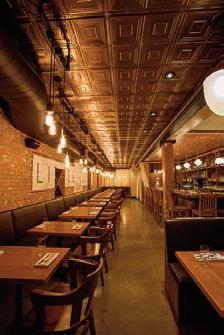

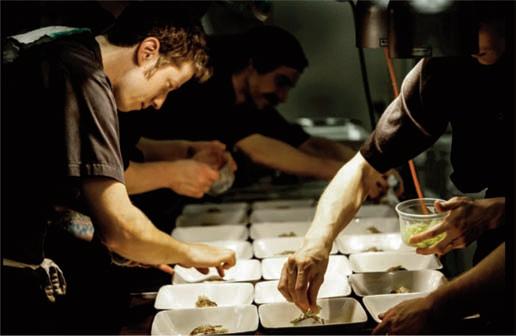
The final word goes to Chef Avila. “In a world where people are starving, we’re lucky to be able to eat local, seasonal food and support a sustainable, environmentally conscious food scene. I love it!”
BY JOSEPH BLAKE & GARY HYNESFiamo Italian Kitchen
515 Yates St., Victoria, BC, 250.388.5824,
fiamo.caOpen daily from 4pm – 2am. Happy Hour from 4pm – 6pm No reservations needed – just drop by.

Fine wines and barrel aged spirits improve with time. For Little Jumbo - now entering its 5th year in business – time has brought an ever-evolving menu and cocktail selection that has helped this internationally recognized Fort Street establishment stay at the top of the Victoria restaurant scene.
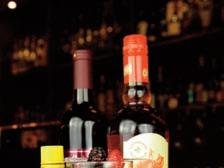
Now their century-old brick building has undergone its own evolution. The upper floors will soon debut as The Fort Street Apartments – nine unique loft-style rental apartments that are bright, authentically sensitive to the historic district, and gorgeous. These suites will add new life and vitality to this great location – and residents will be only steps away from what has become one of Victoria’s best food and beverage experiences.
International travellers and savvy locals find their way to the down-the-hall location of Little Jumbo, where the award-winning bar team uses premium ingredients and precision mixology to create anything you desire. But for many regulars, the six-week rotation of eight, highly original creations remains the draw. And the dining is the equal of the bar experience. With the finest seasonal fieldfarm and sea-to-table ingredients and meticulous preparation, the Little Jumbo kitchen team produces some of the most creative and palate-pleasing food on the Island.
Walk down the newly revitalized hallway at 506 Fort Street, swing open the big door, and let Little Jumbo transport you back to the prohibition era in a stylish room created by restaurant designer Sara Baxter. Awarded ‘Best
Commercial Design’ on Vancouver Island in 2014, Little Jumbo stands alone in terms of feel and authenticity. Home to a happy, dedicated kitchen team, award-winning bartenders, and an exceptional wine selection, Little Jumbo provides a fresh, vibrant, quality experience for its guests. With knowledgeable, friendly service staff, and a unique interior space, Little Jumbo looks forward to welcoming you seven days a week from 5 PM until late. 506 Fort Street, Down the Hall, Victoria, BC, 778-433-5535, littlejumbo.ca
There's a lot going on at 536 Yates street. For 26 years Ferris' Downstairs Grill and Garden Patio has been a local institution, a cozy space where guests know they can come to find great food that is reasonably priced, freshly made and unique. With a freshly renovated bar and kitchen, the downstairs grill is ready for another 25 years
Heading upstairs, directly above the downstairs grill, Ferris' Upstairs Seafood & Oyster Bar is an extension of the Ferris' feel, with a slightly more up-scale menu.
Featuring deeply coloured wooden floors and rich brick walls accented by candlelight - all of which is supported by a great wine list, the best in fresh local seafood and premium steaks.
Heading sideways, you can find Perro Negro (Black Dog).
Born of a love of Spanish food and culture, Perro Negro features an extensive list of tapas, sherry, and wine from Spain, BC, and beyond, served in an atmosphere that is lively, casual and fun! Perro Negro is also a great space for private parties and events.
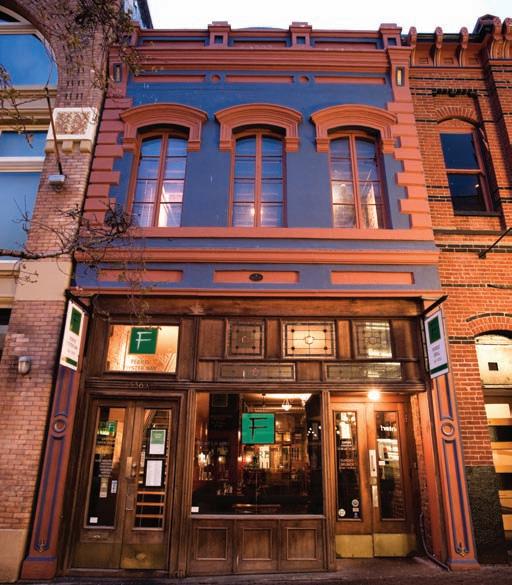
A brief walk away is the fourth member of the family. Catalano Restaurant & Cicchetti Bar, located in the Magnolia Hotel, presents comfortable, dining in a casual yet upscale environment.
With a menu drawing influences from the Mediterranean, in particular Italy & Spain, Catalano features both local meats and seafood, an extensive cicchetti menu (Italian tapas) and Victoria's best happy hour.
Up, Down, Sideways or down the road, the locally owned and operated Ferris' Group offers something for everyone!
Ferris' Grill & Garden Patio
Ferris' Upstairs Seafood & Oyster Bar
Perro Negro
536 Yates Street Victoria BC 250-360-1824 ferrisoysterbar.com

Catalano Restaurant & Cicchetti Bar
619 Courtney Street Victoria BC 250-480-1824 ferrisoysterbar.com
BeaverTails® pastries are deliciously addictive, whole-wheat Canadian pastries, handstretched to resemble the tail of a beaver and served piping hot with your choice of delectable toppings.

Owners Yann Fougere and David Boetti have been friends since attending university in France. They dreamt up the idea of bringing a bit of France to the Canadian West Coast, while continuing to provide impeccable customer service. After many years arguing over France’s best dessert, the two finally agreed on the Macaron and its infinite flavour possibilities, and Bon Macaron Patisserie was born. With three locations in Victoria and Vancouver (Granville Island and Ktsilano), Bon Macaron Patisserie offers a vast and ever-changing variety of sweet and savoury macarons, made with the finest ingredients. Macarons offer all the pleasure of a rich treat but are as light as air. With their small size and weightless consistency, people can enjoy them without feeling guilty!
1012 Broad St, Victoria, BC, 778-265-0850 bonmacaronpatisserie.com
The first BeaverTails pastry was sold in 1978 out of a small kiosk in downtown Ottawa. More than 30 years later, BeaverTails® has become a Canadian icon, frequently included in top 10 lists ranging from National Geographic to BuzzFeed to
USA Today
Our Victoria store, which is locally owned and operated, is located a few short blocks from the Inner Harbour and has been serving up these irresistible treats since June 2015. Our menu includes a diverse list of snack options, including poutine, fruit smoothies, and gelato which we create in-store.
602 Broughton Street, Victoria, BC, 778-440-8245, beavertails.com























































 STORY by Joseph Blake PHOTOGRAPHY by Rebecca Wellman
STORY by Joseph Blake PHOTOGRAPHY by Rebecca Wellman




SOMETHING VERY EXCITING IS HAPPENING north of the Malahat. Young and not-so-young urban dreamers have flocked to Cowichan Valley’s warm, rich farmland in the past few years, creating a robust food scene of organic farms, wineries, breweries, distilleries, tea plantations, dairies, cheese makers, butchers, community markets, cafés, food trucks and fine dining rooms working together synergistically to create a growing, ecologically based, sustainable and very idealistic culinary community. Duncan is the commercial hub with a population of about 5,000 followed by Cowichan Bay with almost 3,000 and Cobble Hill with less than 1,000. Working together and supporting each other’s efforts, the Cowichan Valley’s small, basically rural population has created a dynamic, impressive food culture.


The Duncan Garage Café and Bakery, Just Jake’s and the Old Firehouse Wine and Cocktail Bar were the pioneering eateries of Duncan’s current food movement. Just Jake’s was established in 1991 and is a local favourite for its great atmosphere, service and pub food. The casual joint owned and run by entrepreneurial couple Liz and Lance Steward supports valley growers and sustainability with an extensive recycling program that includes converting their fryer oil into biodiesel fuel to power their vehicles and turning mash from the brewery next door into food for local pigs. They opened Craig Street Brew Pub in 2006, Jake’s at the Lake in 2012, and partnered in establishing Red Arrow Brewery two years ago.
In many ways, the Duncan Garage Café is at the heart of the Cowichan Valley’s food scene, a 2,000-square-foot, open-mall gathering place for everyone from yoga moms and businesspeople to old hippies and spandex-clad bike riders. Current owners Nicolette Genier and Susan Minette have been part of the café’s team for over a decade, back when the renovated heritage building included a sprawling Community Farm Store. In 2014, the farm store moved to a larger building just south of Duncan, where a staff of 50 self-described “tree huggers” offer a huge range of locally grown, non-GMO, certified organic and fair trade products.
At the Duncan Garage, manager Leela Heyward assured me that “everything on our menu is from local sources and made from scratch.” As I finished my country breakfast at the busy café, Heyward added, “Our goal is to reach 100 percent organic ingredients in our menu.”
Over at Duncan City Square, the Old Firehouse Wine Bar is another Valley institution that its charismatic owner/bartender Jeff Downie opened in 1998 as a bookstore. In 2012, Downie transformed the heritage site into a 100-seat bistro and late-night hangout with live music most weekends. Executive chef Ian Blom and his brother Chris change the locally sourced, tapas-style menu seasonally. The Blom brothers cure their own meats and make their own bread and pasta on a menu of classic bistro fare with a creative flair. Manager Chey Peterson works the front of house to create a warm, urbane vibe, organizes the live music.






One of the newest additions to the Cowichan Valley’s growing food scene is Pizzeria Prima Strada. The popular Victoria-based company closed their Rock Bay location

The robust, sustainable and idealistic food culture of theCowichan Valley.
and moved the Mugnaini wood-fired oven to a culinary plaza in rural Cobble Hill that is also home to Drumroaster Coffee and Cure Artisan Meats and Cheese. The new pizzeria opened the 65-seat Cobble Hill restaurant in March featuring the brand’s Verace Pizza Napoletana Certified offerings and a certified carbon-neutral, awardwinning green business operation. They have a 26-seat seasonal patio for al fresco dining too.
Neighbouring Drumroaster Coffee opened in 2007 but the Oglend family patriarch Geir Oglend is a veteran of the coffee business and installed his first espresso machine back in 1972. Geir’s wife, Patricia, creates the recipes for all the tasty treats served at Drumroaster. Their son Carsen now handles the Roaster’s ethical sourcing and coffee roasting, while daughter Courtney manages front of house and barista training. Courtney’s husband Andy serves as the family operation’s mechanic. On May 28, Drumroaster celebrates a block party with a special coffee lager developed with another Valley newcomer, Chemainus’s Riot Brewery
Cure Artisan Meats and Cheese is another neighbour at the same busy Cobble Hill corner. Brad and Leah Boisvert owned Amusé Bistro before opening Cure to produce their own classic charcuterie featuring slow fermentation, dry cure, real-meat-nofiller products and sell artisan cheese from around the world. They sell Cowichan Pasta Company’s fresh pasta made from organic, Duncan-grown hard spring wheat, emmer and spelt, products you can also find at Moss Street Market. Using Red Arrow Brewery’s darker beers in their beer mustard and Cowichan Bay’s True Grain Bakery bread in their sandwich offerings, Cure makes everything from scratch. Be sure to take home a bottle of their red onion jam. They also sell it and other house-made products at Root Cellar in Victoria.
Saisons is a charming country bakery just north of Duncan open only on Saturday and Sunday in season. Deck tables overlook their vineyard and surrounding mountains, a glorious view matched by Saisons’ delicious baked goods, and breakfast and lunch menu items. Favourites include various fruit tarts, savory pizza-like focaccia, quiche, scones, brioche, and crepes at this tiny, Valley treasure.
Jessica and Jeremy Fetchko’s Fishbowl Cafe opened last October on a busy corner in Duncan. They serve local Drumroaster Coffee and Westholme Tea Farm with housemade baked goods, soups and sandwiches using local, organic ingredients. The bright, large space is homey and comfortable.
Ampersand Distilling Company is a fixture at the Duncan Farmer’s Market. The father-son team of Stephen and Jeremy Schacht used their engineering backgrounds to design and build stills to produce popular, award-winning Ampersand Gin and Per Se Vodka on their five-acre, organic wheat farm managed by Steve’s wife Ramona (where she also grows berries, row crops and heirloom tomatoes) and aided by Jeremy’s wife Jessica McLeod, who helped found the distillery and create Ampersand Gin’s distinctive recipe. It’s a truly family business.

There's an excellent sense of community being fostered here, from the mixing of customers and producers at the Duncan Farmers' Market to the collaboration of businesses. The beautiful setting, the wonderful people, and the connections to be made make this an ideal place to start a business. There is the opportunity to do something new here, and that's very exciting.”
- Jessica Schacht, Ampersand Distilling Co.

Last year Liz and Lance Steward of Just Jake’s teamed up with chef Dan Hudson to launch Jake’s on the Road, a food truck based at their Red Arrow Brewery. As well, Taco Revolution’s food truck shares the brewery’s parking lot for $3 Taco Tuesdays. And the Mexico connection continues with Guillermo Oliva’s Mexican Food Mafia food truck, a fixture in the Valley at weddings, corporate events and Duncan’s year-around Saturday Farmer’s Market. Since moving from Guadalajara in 2012, Mexican Food Mafia has become a vital part of the scene here and Oliva is building two, new food trucks for the summer season.
Old Firehouse Wine Bar manager Chey Peterson runs Wild Thyme Catering, a food truck at the Duncan Farmer’s Market that features fusion cuisine and local meats and produce.





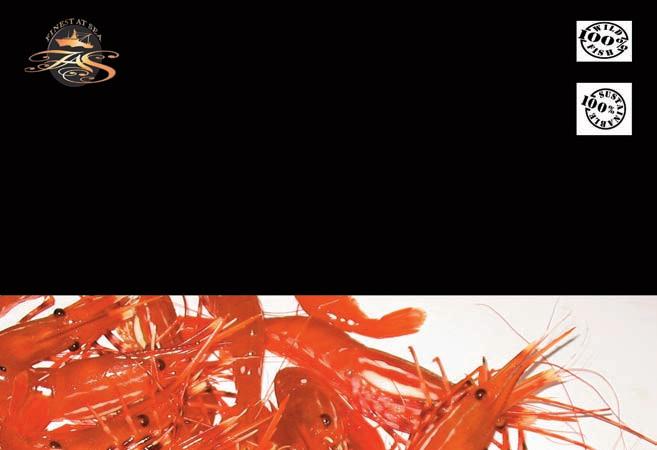
With an expansive, glorious view of Unsworth Vineyard and the Valley’s western edge, chef Maartyn Hoogeveen and manager Mark Niven Pope run Unsworth restaurant in a beautifully renovated old farmhouse that celebrates the Valley’s abundance. Chef’s classical bistro fare uses local ingredients in a seasonally inspired menu of small and large plate offerings for lunch and dinner. Their wine list includes wines from the award-winning winery bought by the Turyk family in 2009.
Andrea Hudson opened Hudson’s on First almost five years ago after her family’s extensive renovation of the 1906 home on the edge of downtown Duncan. Attention to detail and a creative showcase of food grown by local, sustainable, organic farms are hallmarks of this 40-seat restaurant (plus a 10-seat lounge with 30 more patio seats added by this season’s expansion). The restaurant’s focus on local sources is underlined by the large collection of art on the walls created by Valley-based artists.

Undoubtably, one the more pleasurable pursuits in the area is wine tasting. At last count the Valley was home to more than twenty-three wineries. The Cowichan Valley wine region has a unique terroir producing mainly crisp, aromatic white wines of great finesse and delicacy with a few cool climate reds to round out the palate.Top grape varieties include pinot gris, bacchus and ortega and pinot noir for reds. The area is also becoming know for sparkling wines. One of pioneer wineries is Vigneti Zanatta which was part of the original winegrowing experiments on Vancouver Island from 1981-86 called The Duncan Project. Among the many wineries open for tasting are Averill Creek Vineyard, Blue Grouse Estate Winery, Rocky Creek Winery, Unsworth Vineyards and Venturi-Schulze Vineyards. New kids on the block are Emandare Vineyard started by Mike and Robin Nierychlo. All of their wines are estate grown, dry farmed organically, with minimal intervention.
The foundation of Cowichan Valley’s food scene, down in the dirty nitty-gritty of growing food, is a host of small, organic farms and their committed farmers. Four additions to the community are Happy Goat Farm, Blue Roots Farm, Raincoast Aquaponics and Farm 1740.

Kirsten Thorarinson and Cory Spencer leased a seven-acre parcel of a 100-acre Duncan dairy farm to create their raw goat milk cheese operation The Happy Goat. They crafted their first batch of cheese in their newly licensed production facility in 2014. Working with Salt Spring’s Moonstruck Cheese and apprenticing in southern France and northern England in 2010 before launching their goat milk dairy in the Valley, the Spencer and Thorarinson sold milk to Hillary’s Cheese and
then began producing their own line of goat milk cheese (Arkleby, Mandolin, Tallentire, Feta, and Tomme de Valée), which they sell at local cheese shops, restaurants and farmer’s markets. They also sell garlic, poultry and eggs.
Courtney Edwards and Dan Adelman of Blue Roots Farm practice sustainable aquaculture and started selling salad mix, culinary herbs and steelhead trout last summer. Using 98 percent less water and getting nine times more production per square foot than ground-based agriculture, their synergistic, greenhouse-based aquaponic system produces steelhead as well as water-born greens, chives, parsley, basil, watercress and nasturtiums for all three Villages Restaurants, Victoria’s new Whole Foods Market and a Valley Veggie Box Program that also makes twiceweekly deliveries to Victoria. They also sell from the farm and plan to transition their aquaponic system from trout to white sturgeon in the near future.
Another aquaculture farm, Raincoast Aquaponics in North Cowichan, also produces greens and rainbow trout in an integrated, hydroponic greenhouse system. They sell their fish and veggies at the Duncan Farmer’s Market, Old Firehouse Wine and Cocktail Bar and the Duncan Garage Café.
Pig BBQ’s Jeff and Lhasa Hetherington recently closed their popular Blanshard Street joint and moved to a farm near Cowichan Bay where they raise small-batch, pasture-raised poultry, lamb, pork, rabbit, free-range eggs and vegetables while making homemade jams and jellies.
“After growing dissatisfied with the large-scale food business, I’m putting my heart into a new venture,” explains Jeff Hetherington. “With my wife and kids in tow, I bought a small farm in the Cowichan Valley and Farm 1740 was born.” Chickens, pigs and lambs will enjoy the good life on the Hetherington land, rotationally grazed on pasture, supplemented with non-GMO feed, says Jeff, “and treated with kindness and respect.” There’s a farm store in the works to sell everything the couple produces: cuts of meat, bone broth, lard and ferments along with various seasonal products and maybe the occasional farm-to-table dinner.
It sounds like the Hetheringtons have found a collaborative home with many other young families in the burgeoning food scene of the Cowichan Valley.
Ampersand Distillery Company, 4077 Lanchaster Rd., 250-818-9336
Averill Creek Vineyard, 6552 North Rd., 250-709-9986
Blue Grouse Estate Winery, 2182 Lakeside Rd., 250-743-3834
Blue Roots Farm, 3965 Rowe Rd., 250-415-2059
Cure Artisan Meats and Cheese, 1400 Cowichan Bay Rd., 250-929-2873
Craig Street Brew Pub, 25 Craig St., 250-737-2337
Community Farm Store, 5380 Trans-Canada Highway, 250-748-6227
Drumroaster Coffee, 1400 Cowichan Bay Rd., 250-743-5200
Duncan Garage Café & Bakery, 330 Duncan St., 250-748-6223
Emandare Vineyard, 6798 Norcross Rd., 250-597-4075
Farm 1740, 1740 Koksilah Rd., 250-893-7675
Fishbowl Café, 580 Cairnsmore St., 250-597-4563
The Happy Goat, 5060 McLay Rd., 250-701-7533
Hudson’s on First, 631 First St., 250-597-0066
Jake’s on the Lake, 109 S. Shore Rd., 250-932-2221
Just Jake’s, 45 Craig St., 250-746-5622
Old Firehouse Wine Bar, 40 Ingram St., 250-597-3473
Pizzeria Prima Strada, 1400 Cowichan Bay Rd., 250-929-4655
Red Arrow Brewery, 5255 Chaster Rd., 250-597-0037
Rocky Creek Winery, 1854 Myhrest Rd., 250-748-5622
Saison, 7575 Mays Rd., 250-597-0484
Unsworth Restaurant, 2915 Cameron Taggart Rd., 250-929-2292

Venturi-Schulze Vineyards, 4235 Vineyard Rd., 250-743-5630
Vigneti Zanatta, 5039 Marshall Rd., 250-748-2338
Westholme Tea Farm, 8350 Richards Trail, 250-748-3811













PRESENTED BY EAT MAGAZINE & NORTHERN QUARTER

Scott Janzen is a third-generation egg farmer from Abbotsford, BC. As a young man, he moved away from the farming life but he came back to it once he had a family and knew that a farm was a great place to raise his kids. Today, he produces two types of eggs for the people of BC. Learn more by visiting BC Egg’s website at bcegg.com
June 12, 6:30 pm




Details on page 10


Venue: Northern Quarter











Tickets: Eventbrite ‘LET’S NOT OPEN A RESTAURANT’








Updates at Facebook.com/EATmagazine



T’S BARBECUE SEASON—time to slap a steak on the grill, fire up the smoker, kick back and enjoy the long days of sunshine. Or is it? Time was, the only issue around choosing a steak was a matter of taste: meaty strip loin, tenderloin or T-bone? Now meat buying is rife with danger, both real and perceived, whether you’re concerned about growth hormones, greenhouse gases, supporting your local farmer or how the animal was raised.
You might even ask whether it’s wise to eat meat at all, what with issues related to diet and health, land and water consumption for meat production, and the high cost of meat that ticks all the ethical boxes.
Earls got into hot water last year when it rolled out its Certified Humane® beef program. But it was Alberta ranchers, not diners, who took issue with the move. Much of the meat was coming from American farms. Earls capitulated, at least partially, and now sources more of its beef from Canadian cattle producers. But the chain remains committed to serving only third-party-verified, humanely raised meats and struggles with short supplies.
According to an Agriculture Canada report, “one in five Canadians said they had boycotted food products because of concerns with animal treatment on the farm and during slaughter.” But even as demand for ethical and humane meat production grows, production is lacking. There’s a growing disconnect between large-scale conventional meat producers and the consumer backlash to their intensive agricultural methods. Cattle are fed in crowded feedlots, chickens in massive barns, sows confined to small farrowing stalls for their entire lives.
Caged animals have been the lightening rod for animal welfare movements and labels like BCSPCA certified and US Certified Humane®. And while these programs have improved conditions somewhat, the vast majority of the more than 100 million farm animals in Canada are raised still in large-scale, conventional operations.
Vancouver chef Chris Whittaker has actually taken beef off his menus because he believes raising commodity cattle is unsustainable, bad for both the animals and the planet. “Beef was an ethical decision,” says Whittaker citing the
“environmental impact” of beef production as a reason for featuring local bison and pork, not beef, at Forage and sister restaurant Timber. Whittaker is careful about the pork and chicken he serves, going directly to local farmers, buying whole animals and using every part to reduce food waste. He cures and ages his own prosciutto, uses trotters and hocks for head cheese, smokes pork shoulders for hours over wood for pulled pork, even uses leaf lard to make his tourtière pastry. There’s pork belly with cracking on the dinner menu and popcorn with pork crackling to munch with drinks.
and even “local” have no comprehensive or legal definitions. You have to ask the person using these labels what they mean. Sometimes they’re legit, sometimes it’s just marketing. Unless you’re buying directly from a farmer who raises your protein to specific protocols, or have explicit trust in your butcher, there are no guarantees.
That’s why “certified” products—those with thirdparty independent verification—are gaining traction, especially with large producers and suppliers.
Brandy Street, manager of the SPCA Certified Program for farm animal welfare, says there are 21 certified farms, mainly in B.C. and Alberta, including Rabbit River eggs, Sumas Mountain grass-fed beef and pork and Little Qualicum Cheeseworks. The SPCA label ensures animals are never caged, fed antibiotics or growth hormones, and have freedom to move, socialize and express natural behaviours.
But even for a chef like Whittaker, the sustainable supply is a moving target. A farm he once favoured has become too popular, their new production methods, to meet growing demand, no longer meeting the chef’s sustainability and animal welfare standards. Humane slaughter is another concern for Whittaker, something that stymies many island producers who must haul animals long distances for processing due to an abbatoir shortage.
Even fast food restaurants are touting RWA (raised without antibiotics) meat, from the beef, chicken and pork at A&W to the certified humane pork at Chipotle Mexican Grill. And, of course, you can buy these certified products locally, whether at Whole Foods, Lifestyle Markets, Peppers, or even Thrifty’s and Save-on Foods. On a smaller scale, labels such as “Metchosin pork” at Red Barn or The Village Butcher indicate animals raised in humane conditions on local farms. Retailers like The Root Cellar or Peppers can tell you how the meats they sell—whether labelled “BC” or “island”—are raised, and at the Ravenstone Farm shop in the Victoria Public Market, or at farmers’ markets, you can talk directly to producers. Slaters brings in Metchosin lamb. Local consumers have lots of choices but need to ask questions to understand exactly what they’re buying.
Clean and green is a priority for many consumers, but words like “sustainable,” “ethical,” “natural”
You’ll also see the US Certified Humane® logo on supermarket meats and menus, and find brands like Maple Leaf touting their new RWA pork products. Quebec’s duBreton, the largest producer of organic and certified humane pork in North America, sells its pork, which is branded Certified Organic, Rustic Farm Pork (antibiotic and cagefree), Raised Without Antibiotics and Certified Humane®, across Canada (including Sobey’s, Whole Foods, Loblaws and Chipotle’s Mexican Grill).
But certification programs come with a cost and, like organic certification, many small producers following best practices don’t sign up.
If simply avoiding antibiotics and growth hormones is your goal, this is what you need to know.
Hormones are routinely used to bulk up Canadian beef because, like steroids in the gym, hormones build muscle faster, making beef cheaper to produce. But in Canada, growth hormones are banned for chickens and pork. If you see “hormone-free” on a package of pork chops, it’s technically true but not worth paying a premium price for.
Antibiotics are another issue. The drugs are often added to animal feed to prevent diseases and at “sub-therapeutic levels” to promote growth in conventional meat production. Conventional producers—especially large commodity agriculture companies—will tell you antibiotics are es-
THERE’S A GROWING DISCONNECT BETWEEN LARGE-SCALE CONVENTIONAL MEAT PRODUCERS AND THE CONSUMER BACKLASH TO THEIR INTENSIVE AGRICULTURAL METHODS.”
sential for animal health, food safety and financial sustainability for farmers.

And labels can be deceiving. Meat labelled “raised without antibiotics” (RWA) means animals were never treated with antibiotics, while “antibioticfree” only says the producer followed standard protocols, withdrawing antibiotic before slaughter to ensure residues in the meat don’t exceed allowable levels.



When food is produced for export in a global market, it’s not surprising there are pressures and incentives for high-volume, low-cost production. But farmers everywhere, small and large, are opting out and choosing to raise their animals a different way.
Tom Henry is an island farmer who raises his pigs in open housing and treats his animals humanely, but he’s not big on labels. When you see pork from his Stillmeadow Farm, or from John Buchanan’s Parry Bay Sheep Farm in Metchosin, it’s humanely raised meat, but there’s no official certification. It’s the kind of meat that butcher Rebecca Teskey chooses for her new Farm and Field Butcher Shop. She personally researches every supplier, curating what’s in the meat case to ensure it meets her standards. Ask anyone behind the meat counter, and they can tell you about every chop, cutlet or steak they sell.
“That’s why we exist—to give that guarantee,” says Teskey. “It’s unrealistic for shoppers to go to every farm.” Teskey understands the difference between “grass-fed” and “grass-finished” beef, pastureraised chickens and what’s in the rations animals eat.
“I know because I seek out that information before I purchase something,” she says. “When I’m sourcing, it’s local first, thinking about three main issues: the environment, animal welfare and your health. But just because it’s from the island, doesn’t mean it’s better.” Whole animals arrive on Tuesdays and Wednesdays. The butchers cut steaks and chops, make sausages, meatballs and burgers, with the goal of selling out by Sunday. While this all comes at a cost, on the day we met, her local, organic whole chickens were cheaper than supermarket organic chickens, as was the local lamb.
“I really wish we could reverse the system so farms that don’t meet organic, humane standards would pay a fee, and places that raise animals well would not.”
The “reductarian” movement is made up of people who “aspire to eat less meat” for personal health, to spare farm animals from cruelty and to reduce their carbon “foodprint.” Reductarians aren’t vegetarians, but they do acknowledge that we consume far more meat than we require and that current consumption levels aren’t sustainable. Animal agriculture uses 30 percent of all land and more than 25 per cent of all water on earth and creates as

many greenhouse gases as planes, trains and automobiles combined, 18 per cent of the total human-generated CO2 and methane. The latest innovations include the Impossible Burger, which looks, tastes and “bleeds like beef.” It’s designed for meat eaters but is entirely plantbased, relying on a molecule called “heme” for its meaty aromas and appearance. The Impossible Burger is on the menu at Momofuku and other restaurants in L.A. and San Francisco—created by scientists at Impossible Foods, a Silicon Valley start-up with financial backing from Bill Gates. Victoria now has its own plant-based meats butcher, James Davison of The Very Good Butchers in the Hudson Market. Preparing a pulled jackfruit taco, Davison says his vegan butchery is the first of its kind in B.C. Offering “roast beast” (a vegan ham), gluten-free British bangers made with leek, apples and herbs, and meatless Reuben sandwiches, the London-born chef offers a unique experience for the omnivore. Davison believes we all need to eat less meat for the health of the planet— something even the UN is advising—and devises his faux meats using tofu, tempeh and seitan (wheat gluten), spices like paprika and beet juice for meaty colour.
So, before you slap another big steak on the barbie, consider the meat, how it was grown, and the implications of eating so much of it. And consider the alternatives.


ANIMAL AGRICULTURE USES 30% OF ALL LAND AND MORE THAN 25% OF ALL WATER ON EARTH AND CREATES AS MANY GREENHOUSE GASES AS PLANES, TRAINS AND AUTOMOBILES COMBINED.”
IT WASN’T ALWAYS THIS WAY. In the early 2000s, craft beer, in Canada at least, was a subculture. And, like other subcultures—say, punk rock or hardcore fetishism—it was fuelled by passion and obsessiveness. There was no money in it. No notoriety. It was (and still is, for the most part) dirty, industrial labour. In the absence of its recent public interest, brewery work attracted mostly malcontents and drunks, like hornets to the sugar bowl. As such, it had a sharp edge, tread only by the reckless and/or dead-ended. And these sweaty, bedeviled slaves to the grist wore their subterranean artistry with a fierce pride, like a full-length, five-colour sleeve tattoo. Back in our mainstream, post-hipster present, Clayton Potter—part-owner/brewmaster at Moon Under Water brewpub—scratches at his wrist. His full-length, five-colour sleeve tattoo is swollen and raw, about twelve hours after its final application. It depicts each vessel from his brewhouse at “Moon,” in whirls of grey and violet, darkly psychedelic. This is not the body art of the casual brewer. This is the visceral expression of a man afflicted. Potter is, on one hand, a throwback to that earlier, Dionysian era of the Craft Beer Renaissance. On the other, he is the New Breed—in his early thirties, comfortable and calm, with no axe to grind. He’s been in it for the long haul since Day One, and since then it’s been a
most interesting ride.
Flashback to his 16th, maybe 17th year, and he’s beginning his first flirtations with the contraband allure of alcohol. He’s the family’s second-born son, and his mother Ann has been through the process already: kids sneaking out on their own, getting blitzed on cheap vodka in dark parks, getting up to “who-knows-what.” So this time around, she tries to establish a sound, supervised introduction to the dark art of drinking. Every Friday, she brings home a six-pack, and Clay, his brother, mother and stepfather each take a bottle and discuss. Each week, a different brand. “By the time I was nineteen, I’d tried every beer in B.C.,” Potter recalls. “And I knew this was something I wanted to do.”
Given the state of the industry described in paragraph one, he surmised that a decent living was only feasible in the laboratories of the major breweries. A UVic degree in microbiology/biochemistry later, he took his first full-time internship at an analytics lab in Edmonton, which proved tedious beyond any expectation. A year later he was back in Victoria, disheartened and out of work. His steelworker stepdad Steve mentioned he’d been fabricating parts for a fledgling brewery right next door to his shop. Clay ran down there, fresh resumé crackling in his hand, but Phillips Brewing Co.
story by DANIEL MURPHY photography by JOHANN VINCENT
was only a one or two-man operation in its cash-starved infancy.
Resumés were blanket-dropped across town. Eventually he heard back from Lighthouse Brewing Co., who brought him onboard as a co-op student to establish a quality-control program and maybe do a little work on the production side. He accepted, becoming a full-time keg washer who was able to sneak into the lab whenever possible, which wasn’t often. But he did manage to apply his studies to the flow of production in a brewery environment. It wasn’t long before he found himself working on the packaging lines, learning the processes of product transfer and filtration, and eventually pulling the valves in the brewhouse. “It became clear that brewing was more interesting, challenging [than lab work]. And I became much more serious about brewing.”
So serious that his lab-specific degree suddenly felt inadequate. “I googled ‘brewing schools,’ but I couldn’t understand German, so I went to Scotland.” In particular, to Heriot-Watt University to earn his Masters of Brewing and Distilling, one of 24 international students to be accepted that year. He completed a thesis on the “Microbiology of Beer in Draught Form,” which, he said, “was great! I needed samples from the first and last pints of the day, so I spent a lot of time in






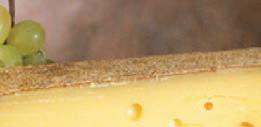



















Scottish bars with my shirt full of pipettes.” The plan was still to go big: InBev, Molson/Coors, etc. But the only positions available for a “junior” brewer were in emerging markets–Africa, China, South America (and not the postcard regions.) It seemed incongruent with a career choice that was increasingly lifestyle-based.
Family ties predominantly brought him back to Victoria, where he shopped himself around for consulting work, which yielded little fruit. Then a brewery much larger and more sophisticated than anything on the Island opened up in Vancouver: Turning Point Brewery, now owned by Labatt, which is now owned by InBev. It seemed as though the pinnacle of Potter’s career arc was coming into focus. But his time there was a mixed blessing: “It was a beautiful, massive brewery, and I was surrounded by super-passionate, talented young brewers. But it was also a little toxic. All we did was talk about all the beers we wished we were brewing.” It was during this period of corporate experience and creative purgatory that Fortune came a-knocking. Friends in the U.S. relayed to Potter’s parents that they had seen an advertisement: “Brewpub for Sale: Southern Vancouver Island.” They quickly did the math, excluded places that could not conceivably be on the market, and deduced that the unimposing, semiretirement project Moon Under Water was the only likely candidate. They approached ownership about the sale, which was coldly denied. When they expressed their interest to purchase, however, things defrosted. Four weeks later, they owned the place. What may seem like fate, finally fulfilled with a “happily-ever-after” ending, was anything but, Potter admits. “At first I didn’t want anything to do with a brewpub. People coming in and immediately judging you, judging your work. But every year I grow a little more in love with it.” Which is a fine sentiment, but those initial stresses were huge. His parents came onboard as part-owners: Ann took over managing the front of house and serving tables parttime (zero experience), and Steve took over as beverage manager and bartender (zero experience), while both had full-time jobs “on the side.” Clay was running the entire brewery, performing mechanical equipment upgrades and then working day shifts in the kitchen (zero kitchen experience).
So the first couple of years were spent climbing a near-vertical learning curve, inexplicably building a strong, highly respected brand that has seen consistent growth since its inception, in an ever-crowded market. But the fledgling brewpub was not built for that surge of success, and instead of abundance, found itself in a state of perpetual need: more fermenting tanks, more storage space, more production time, more staff, more efficient packaging equipment, more kegs, more credit with suppliers. Cyclone Success came with brute force, devastating best-laid plans and lifestyle aspirations. “I became over-immersed in beer, brewing every day, alone for long stretches,” Potter recalls.
It was at this time that Aprons for Gloves gained popularity, a charitable, hospitality-industry initiative created by the Eastside Boxing Club in East Vancouver. While raising money for abused women and “at-risk” youth, it created a stage where briefly coached service staff could whack the shit out of each other in front of a paying crowd. The first event raised $35,000. The surprisingly large number of brewing industry participants led to a breweryspecific now known as Beer Wars. Clay recalls his first involvement in Aprons: “We were the third fight, we busted up our faces, blood everywhere, gassed out halfway through… it was awesome. We were the spectacle of the night. And I squeezed out the win.” Thus began a new and insatiable thirst—for Victory. “Boxing was perfect timing. I had no spare time. It forced me to take time off, to train… otherwise I’d get my ass kicked.”
Clay has pursued the sport with abandon and now boasts a 3-2 win/loss record in legitimate amateur fights (on the same level of professionalism as Olympic boxing), fighting in weight classes ranging from 194 lbs to 147 lbs, but, he laughs, “This will be my breakthrough year.” And you can see it written clearly in his features, his right eye a little darkened from sparring, his nose showing subtle changes in direction from one visit to the next. But it’s most evident in his assured smile, a tangible self-confidence that one obtains from punching someone else repeatedly in the face, and vice-versa.
You’re just as likely these days to see his lean silhouette shovelling mash from your seat in his pub as you are to see him training at-risk youth and women recovering from domestic abuse in his new position as director of the not-for-profit Victoria Boxing Club (Douglas Street at View). He’s there six days a week, throwing himself into this new ring with the same dedication and intensity he has had, for all these years, in his various brewery positions. I tell him his record has been a little more convincing in the brewing field, at which he flashes that boxer’s smile and jokes that he’s “just getting started.” I believe him and quietly suggest to myself that I tread a little more carefully.
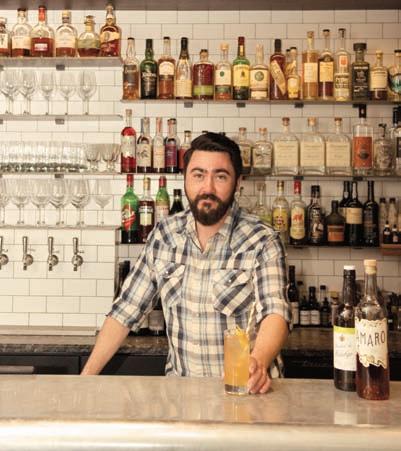
world.Whether drunk as a liqueur or used as a flavouring agent, bitters will be lined up in any cocktail bar worth its smoked Himalayan sea salt. Classic amaro from Europe, traditionally drunk as an after-dinner digestif has become a hot commodity in British Columbia in the past few years. From the dry aromatics of Fernet-Branca (considered the world over as the “bartender’s handshake”) to the sweet and alluring bitterness of Amaro Montenegro, each has its place in the cocktail kingdom. And, of course, with the creativeness of local distilleries, it wasn’t going to take long before our own B.C. interpretations started hitting the market.
Amaro is a relatively easy liqueur to describe. A fairly neutral spirit base is infused with a variety of herbs and spices. Each amaro from Europe is usually very specific to its region, crafted to be paired with the local eating and drinking habits. Each brand has slight variations in production and its own formula of ingredients (usually heavily guarded), but the end result is bitter forward.
Here in B.C., the first on the market was Woods Spirit Co.’s Pacific Northwest Amaro, created by the North Vancouver distiller after the Campari shortage in British Columbia a few years ago. Heavy on rhubarb and grapefruit, this amaro uses a rotovap or vacuum distillation, which ensures the bright flavours in the ingredients are still vivid in the final product. Mia Amata from Odd Society Spirits in East Vancouver has been a recent addition to the mix. The creators of Bittersweet Vermouth gave it a sibling that shows master distiller Gordon Glanz isn’t done with recreating old recipes found in dusty books. Thick and viscous, with a balanced bite of bitterness and herbal tones, it is remarkably different from the Woods Spirit Amaro.
Naramaro, the latest endeavour from Doug and Dawn Lennie of Legend Distilling in Nanaimo, will be making an appearance in May. Naramaro is set to recreate Amer Picon, a very rare, classic, orange-heavy amaro from France that is the necessary ingredient for the Brooklyn cocktail.
If you haven’t been paying attention, Agrius on Yates Street has become one of the most awarded restaurants in British Columbia in 2017, and there are a lot of reasons for this, including a bar program originally started by Adam Bonneau (Ulla, Little Jumbo and North 48) and now being spearheaded by industry veteran Brooke Levie of Marina and Café Brio fame. The bar program has always been locally, seasonally and farm-to-table focussed, with an eclectic mix of local spirits and industry favourites. Since taking over the bar, Levie has set about polishing each aspect of the menu and giving each cocktail his own twist.
The Fino Spritz is one of those cocktails—low in alcohol, balanced and, if you love your sherry, a must-try. The fino sherry balances out very well with the citrus soda and the Woods Spirit Co. amaro. Topped with soda, it is simple and delightful, what is sometimes called a “sessionable” cocktail, i.e., something you can consume a few of on a Sunday afternoon on the deck at Agrius. Brooke, as always, is understated in what he has created at Agrius. The room is warm but semi-formal, the bar apparent but not obvious and the cocktail menu reads like a cocktail geek’s handbook. All the bases are covered.

THE FINO SPRITZ
2 oz. fino
2 oz. Woods amaro
2 oz. citrus cordial
• GLASS - Highball
• BUILD - over ice
• TOP - with 2-3 oz soda
• GARNISH - With a lemon twist
and I have been trying to convince anyone who would read us that sparkling wine could be enjoyed any day of the week, regardless of the occasion or non-occasion. Somewhere along the way, it happened, though I can’t claim it was our doing.
The first piece of good news, in my opinion anyway, is that sparkling wine consumption is on the rise. In 2014, the Organisation Internationale de la Vigne et du Vin (OIV) reported a 30 percent increase from 2003-2013. Even more significant is when and how bubble is being consumed. “It is now spread throughout the year,” the report continues. “Sparkling wines have come to be consumed in a more regular and less specific manner.” This means people are drinking it as an aperitif, in cocktails and even throughout the meal rather than just to toast the New Year, significant birthday or anniversary.
Where does Canada fall into this fizz frenzy? Well, we aren’t among the top sparkling wine consuming countries in the world according to the OIV study. But, hey, we don’t have the same wine culture and tradition as Germany and France (#1 and #2 respectively). And our population is tiny next to Russia and the U.S. (#3 and #4). However, here in B.C. we are aligned with global trends. Master of Wine Barbara Philip is the category manager for sparkling wine at BC Liquor Stores. She calculated BC Liquor Stores sales as well as hospitality (a.k.a. restaurant etc.) purchases for me. From April 2016 to February 2017, we spent a whopping $38.8 million on two million bottles of beautiful bubbles. That is up 12.65 percent by value and 5.8 percent by volume from the previous year.
There are no prizes for guessing which sparkler is popped the most. Prosecco is surely one of Italy’s biggest success stories. We’ve embraced it wholeheartedly in B.C., and our enthusiasm shows no signs of waning. It accounts for $10.6 million (up 23 percent) spent on sparkling wine. Prosecco’s popularity can be attributed to a couple of key factors. Price is paramount. On our shelves, most brands sell for less than $25. It is also just so approachable in style. Prosecco gets its bubbles from a second fermentation in large tanks. (Often referred to as the Charmat method.) It’s bottled almost immediately after for a fresh, fruity and uncomplicated sparkler. Neither the mousse nor the acidity is aggressive. I’d also say the connection with Italy’s dolce vita lifestyle adds to Prosecco’s appeal. We owe Prosecco a ton for making
sparkling wine a regular everyday sipper. Champagne sits at the other end of the spectrum. It starts at $50 a bottle in B.C. and quickly increases from there. Thus the association with special occasions. There are reasons for the higher price. Champagne gets its effervescence from a time-consuming and expensive process. Known as the traditional method, the second fermentation happens within the actual bottle you end up drinking from. But before you are able to buy it, Champagne is aged on the lees for at least 15 months, if not years, giving it a marvellous biscuity complexity. The cool region of Champagne means that the wines have racy acidity and can be somewhat austere. While Champagne isn’t to everyone’s tastes (or budget), sales aren’t suffering. By value, it is neck and neck with Prosecco in B.C. at $10.4 million (up 17 percent).
If my math calculations are correct, according to Philip’s stats, Champagne and Prosecco combined account for approximately 54 percent of sparkling sales in our province. What about the remaining 46 percent? Well, herein lies a fascinating world of diverse bubblies each deserving their own specific article. Some are made like a Prosecco while many others riff on Champagne’s traditional method. Beyond their production technique, each is unique thanks to the grapes used and the climate and soil they grow in. Most important, they offer stimulating alternatives to their better-known brethren. Below, I’ve selected some of my top picks that aren’t Prosecco or Champagne. I tried to find those that are reasonably priced enough to incorporate into your daily, or at least weekly, sparkling rotation. Curious bubble fans will be rewarded.
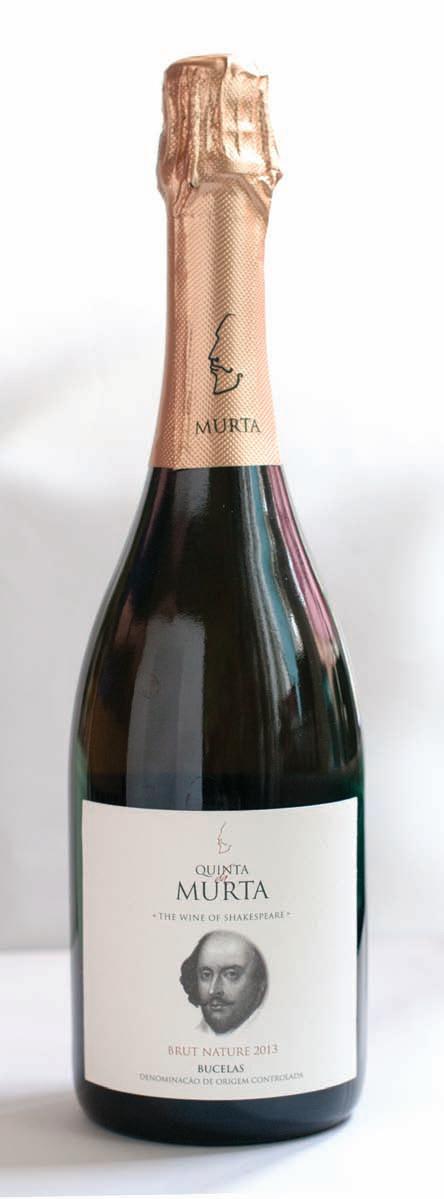
“And now for something completely different.
Lambrusco is a family of grapes making a whole host of delicious sparkling reds. ”
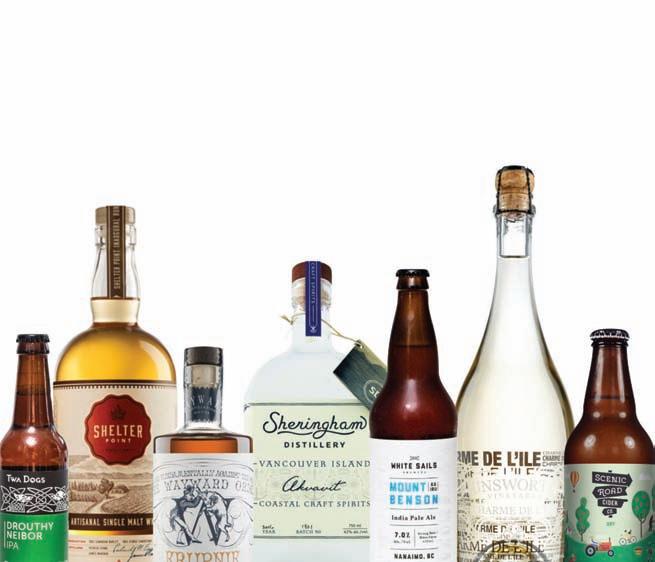






FRANCE $27-30
Outside the region of Champagne, France’s high quality sparklers made using the traditional method are called Crémant. Here’s a friendly example from the region of Burgundy. Made with Pinot Noir and Gamay, it bursts with wild strawberry, cherry blossoms and grapefruit peel. A lovely match for salmon with first-of-the- season berries.
N/V CALMEL & JOSEPH, BRUT, BLANQUETTE DE LIMOUX AOC, FRANCE $29-32
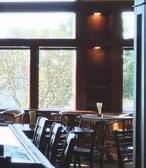
The southern French region of Limoux sits in the foothills of the Pyrenees mountains. It has a long history of producing sparkling wine based on the obscure Mauzac grape (known l ocally as Blanquette). Pretty scents of apple blossoms with appealing flavours of orchard fruit and butter cookies carried by zesty succulent acidity.
N/V FERRARI, BRUT, TRENTO DOC, ITALY $20-33


Prosecco is not the only Italian bubble. The lesser-known denomination of Trento DOC is reserved solely for top-notch traditional method bottles. Crafted from 100 percent Chardonnay, Ferrari’s Brut offers aromas of lemon curd on toast and flavours of golden delicious apples. Brisk acidity and slowly melting bubbles counter fried specialties like fritto misto and fish and chips.
N/V PALTRINIERI, ‘PIRIA’ LAMBRUSCO DI SORBARA DOC, ITALY $22-24
And now for something completely different. Lambrusco is a family of grapes making a whole host of delicious sparkling reds. The Lambrusco di Sorbara variety is the palest of the bunch, giving rosé-looking wines. With Lambruscos, the tank method is widely used to preserve youthful fruity exuberance. The Piria has plenty of that with gorgeous violet, crunchy cranberry and fresh raspberry notes. Just what you need when feasting on charcuterie.
2012 AGUSTÍ TORELLO MATÁ, BRUT RESERVA, CAVA DO, SPAIN $29-32
Not all Cava is simply cheap and cheerful. When I’m craving a bit more finesse and nuance, more ambitious offerings like the Agustí Torello Matá still offer exceptional value. Earthy herbs and fennel meet juicy pear and a salty suggestion. Twenty-four months aging on the lees lends hints of baked bread. Firm and dry, it’s made for cleansing the palate between lusty tapas bites.
2013 QUINTA DA MURTA, BRUT NATURE, BUCELAS DOC, PORTUGAL $27-30
One of my favourite new finds. Featuring the zesty Arinto grape, the Quinta da Murta hails from Portugal’s tiny Bucelas region (just north of Lisbon). A super- bracing bubble with a briny sea breeze twist and mouthwatering white grapefruit nuances. Unequivocally dry, it is a treat with oysters.
2016 BELLA, ‘HILLSIDE’ SPARKLING ROSÉ, BRUT NATURAL, BC $26-28



Besides early adopters Blue Mountain and Summerhill, B.C. wineries like Haywire, Fitzpatrick and Bella are all making delightful bubbles. Going out on a limb, Bella focuses on sparkling wine exclusively. Among the latest releases, the 100 percent Gamay from Hillside gets my top vote. Beautiful pale salmon hue with hints of sumptuous summer berries and pure rose petals.
N/V UNSWORTH, CHARME DE L’ILE, SPARKLING WINE BC $23-25
The cool reaches of Vancouver Island also offer a couple of fun sparklers. The registered “Charme De L’Ile” moniker can be used only for wines made using island grapes and refers to the Charmat method. It is our local answer to Prosecco, though the wines boast brighter acidity (a good thing!). Unsworth’s charming blending of Pinot Noir, Pinot Gris and Sauvignette makes for a green apple, bosc pear, light-on-its-feet guzzler. (Note: The Charme De L’Ile from Averill Creek Vineyard is also worth checking out.)
N/V JANSZ, PREMIUM CUVÉE, TASMANIA, AUSTRALIA $30-33
Name a style of wine and Australia probably makes it, including excellent fizz. For these, they rely on the coolest of their regions, with the island of Tasmania being particularly well-suited. Jansz is modelled on Champagne using the same method and blending classic varieties Chardonnay and Pinot Noir. Think nuts, citrus and red currants with persistent lingering mousse.
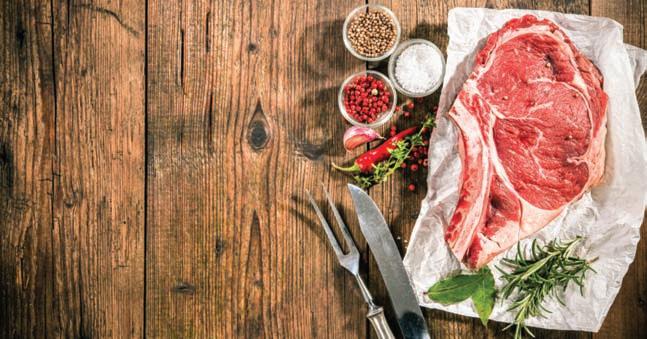

SPIER SIGNATURE CHENIN BLANC 2016
SOUTH AFRICA $13.50-16.00 $13.50-16
Established in 1712 in the heart of Stellenbosch, Spier is one of the oldest wineies in South Africa. The vineyards are now managed using Biodynamic techniques and the results are nothing short of miraculous. Very floral on the nose with lovely citrus and tropical fruit flavours and a rich core of zingy acidity. Textbook Chenin Blanc from the cape. whitehall.ca
CARMEN WAVE SERIES SAUVIGNON BLANC 2016 CHILE$12.00-14.00
Some wines are made to drink and enjoy, not to ponder and consider. This elegant little Sauvignon Blanc from the Leyda Valley is light and fresh with zesty lime and grapefruit aromas. Very lively with mouthwatering acidity and bright citrus fruit flavours. A charming little delight to quaff and forget at a price that will get you thinking. selectwines.ca
JOIE EN FAMILLE RESERVE RIESLING 2015 NARAMATA BENCH $25.00-27.00
Off dry and beautifully balanced with superb concentration, ripe citrus, apricot and ginger flavours and rapier like acidity. Took home “Double Gold” at the recent 2017 Cascadia Wine Competition. Top-notch! joiefarm.com
BERNARD DEFAIX CHABLIS 1ER CRU COTE DE LECHET 2015 FRANCE $35.0038.00
Bernard Defaix is the largest Domaine in the Cote De Lechet, owning 8 hectares of the 37 hectare premier Cru. It is also the site’s only certified organic grower. The 1er Crus of the Cote De Lechet are better know for their elegance than their power but this Chablis has it all. The nose is very provocative with subtle apple, citrus, saline and mineral aromas. Beautifully balanced with layers of ripe, fleshy fruit and a chalky minerality. liffard.com
PENTÂGE PINOT GRIS 2015 OKANAGAN VALLEY $20.00-22.00
Pentâge Winery sits on 35 acres of prime real estate overlooking Skaha Lake just outside of Penticton. Lush and expressive with ripe pear, honey and mineral flavours, good weight and a slightly oily texture. Nicely balanced with a long dry finish. pentage.com

THERAPY VINEYARDS PINK FREUD 2016 OKANAGAN $16.00-18.00
This immensely popular Okanagan rosé is a blend of Pinot Noir, Merlot and Pinot Meunier. Initially treated in the winery like a red
LARRY ARNOLDwine, the must is allowed a cold soak on the skins for two days then bled off into a stainless steel tank for primary fermentation. From here on in its treated like a white wine. Bright pink and very aromatic with concentrated cherry, plum and strawberry flavours. Off-dry with a long, juicy finish. therapyvineyards.com
FATALONE PRIMITIVO GIOIA DEL COLLE 2014 ITALY $19.00-21.00
I reviewed the 2006 vintage back in the summer of 2011 but the current release bears close scrutiny as well. Decanter Magazine, the wine bible of the British wine hoipoloi, recentely proclaimed Fatalone to be “one of the very top Puglian producers.” It all began with Filippo Petrera “Il Fatalone” which in the local jargon means “irresistible heartbreaker.” To maintain his mojo with the ladies, Don Filippo began each day with the crosswords and a half a litre of milk washed down with an equivalent amount of Primitivo. There were no complaints and he lived to the age of 98. Today, winemaker Pasquale Petrera runs the show with the same passion but a little more focus on the job. The vineyards are now certified organic and the winery has been certified 100% sustainable with a zero carbon footprint. This is a very interesting stuff and good for the planet as well. It is an approach we need to see more of if we want to continue to enjoy the occassional glass of wine and survive as a species. The wine you ask, is it any good? Well, as a matter of fact, the current vintage is very good. It is rich and concentrated with a big nose and a flavour profile that offers up much in the way of sweet, spicy fruit flavours that just go on and on. libertywineimports.com
BISCEGLIA TERRE DI VULCANO AGLIANICO DEL VULTURE 2013 ITALY $15.0017.00
Aglianico del Vulture is one of the great red wines of southern Italy. Located in Basilicata, at the southern extreme of Italy, Azienda Agricola Bisceglia was founded in 2001. Based in the Lavello near the base of Mount Vulture, the state of the art winery is supplied by a 30 hectare vineyard planted on the region’s famous, dark volcanic soils. The 2013 Aglianico has pronounced aromas of blackberries, spice and earth. Medium to full-bodied with good weight, concentrated fruit flavours balanced with a firm tannic backbone. whitehall.ca
ESPORÃO PÉ TINTO 2015 PORTUGAL $12.50-14.50
This hearty blend is big and chewy with layers of fresh blackberry, strawberry and spice flavours held in check with a backbone of firm tannins. Another value priced Portuguese table wine made for everyday drinking enjoyment. seacove.com

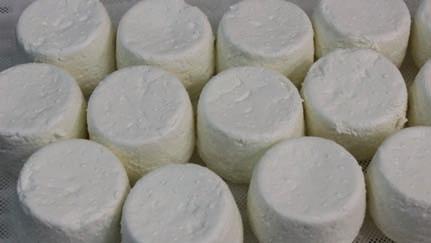
Please support the advertisers featured here as their support allows us to offer this magazine free of charge.
Hudson’s On First
Award winning dining in a beautifully restored heritage home. Local ingredients, classic techniques and made from scratch cooking are a just few reasons to visit us in Duncan more often. Celebrate Bubbles & Brunch, Lunch and Dinner.

163 First St. Duncan, BC, 250-597-0066, hudsonsonfirst.ca
Duncan Garage Café & Bakery
Serving up healthy and delicious vegetarian food 7 days a week. Check out our spring menu. Blending up super food smoothies for your spring health. Looking forward to serving you healthy and vibrant Duncan Garage Creations.

330 Duncan St., Downtown Duncan (across from the railway station), 250-748-6223

Henri Procter Realtor

New kitchen, new home? Henri is an award winning Realtor, serving Saltspring for 30 years. Positive, friendly and professional, Henri will excel in finding your perfect match.
Henri Procter, MacDonald Realty, 250.537.1201, henriprocter@gmail.com
Fernwood Road Café
A funky little café with an incredible view, great coffee and lots of home baking - for breakfast, lunch and dessert. Spring Hours (closed Wed) Weekdays 9 - 5, Weekends 10 - 5

325 Fernwood Road (just across from Fernwood dock, north end) Salt Spring Island, 250-931-2233, Fernwoodcafe.com


Adrienne’s Restaurant & Tea Garden
Come visit our Bakery, Deli, Ice Cream Parlour, Restaurant and Tea Garden and celebrate our 60th anniversary! We’ll be doing a monthly draw for a gift bag valued at $60. We look forward seeing you at Adrienne's! To all our guests: “Thank you for your Patronage!”
Enjoy the sun on our outdoor patio this summer!
5325 Cordova Bay Road, Victoria, BC, 250-658-1535 AdriennesTeaGarden.com
Whisk
WHISK is a fully stocked kitchen and gift shop. We are located in the busy Victoria Public Market downtown. Gift and wedding registry available. Check us out on social media. At the Victoria Public Market, 778-433-9184, whiskvictoria.ca, Facebook and Instagram. Open 7 days a week
Kitchenware

